RRP: Contact Predator Tyres for price
AVAILABLE FROM: www.predatortyres.com.au
WE SAY: A new tyre to the market but one that is so far proving to offer a good blend of on- and off-road performance.
The first shipment of vehicles landed locally earlier this month, with the allotment dispensed to dealerships to fulfill back orders across the country.
Two T9 variants are available to order, starting at $45,670 (driveaway) for the lower-spec Oasis and topping out with the upper-spec Haven. Both variants are powered by the same 125kW/410Nm 2.0-litre turbodiesel running through a ZF eight-speed auto and part-time 4WD system.
“We’re thrilled to begin deliveries of the JAC T9 Ute to our Australian customers,” said Ahmed Mahmoud, JAC Motors Australia Managing Director. “The JAC T9 Ute is a ‘smart choice’ for buyers seeking a blend of value, design, and leading cutting-edge safety.
“We have also made sure that every JAC T9 comes with an uncomplicated, seven-year, unlimited kilometre warranty and affordable capped price servicing.”
The JAC T9 received a five-star ANCAP safety rating back in August 2024, scoring 85 per cent (adult occupant protection); 87 per cent (child occupant protection); 87 per cent (vulnerable road user protection); and 89 per cent (safety assist).
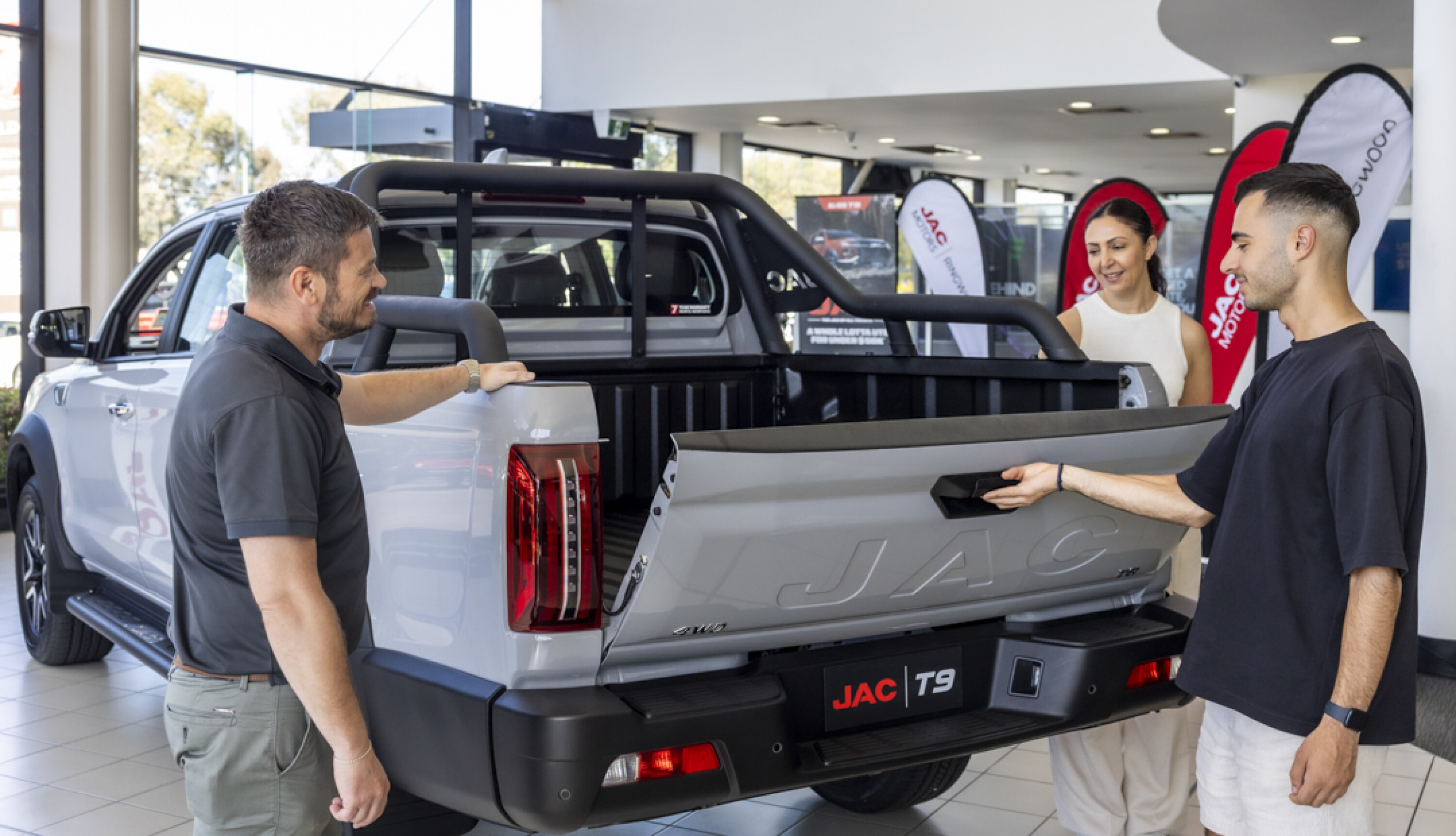
“JAC has clearly committed to bring high levels of safety performance to the Australian market with the T9 and are to be commended for achieving these strong results with their first offering,” said ANCAP Chief Executive Officer, Carla Hoorweg.
Safety equipment includes seven airbags and a suite of active safety features: forward and reverse autonomous emergency braking; lane-keep assist; lane departure warning; lane change assist; blind-spot monitoring; rear cross-traffic alert; traffic sign recognition; a driver monitoring system; and adaptive cruise control with traffic jam assist.
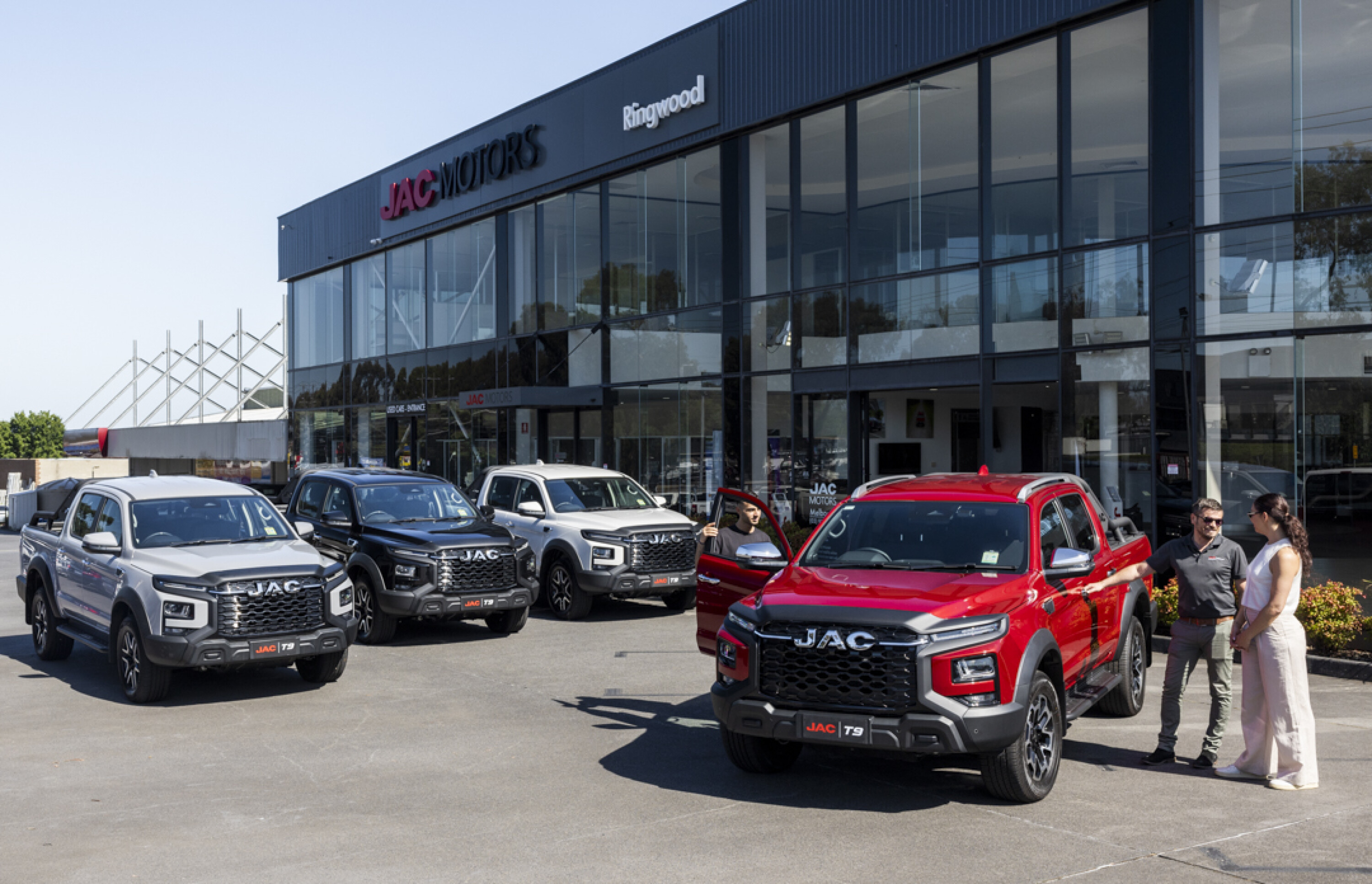
On the inside, the Oasis features a 10.4-inch infotainment touchscreen and digital instrument cluster; smartphone mirroring; wireless charging pad; LED lighting; climate control air-conditioning; reversing camera; rain-sensing wipers; and 18-inch alloy wheels. The Haven then adds rear privacy glass, 360-degree camera, and heated front seats.
| 2024 JAC T9 Oasis features | |
|---|---|
| 18-inch alloy wheels | Remote window open/close control |
| Highway terrain tyres | Rain-sensing wipers |
| 10.4-inch infotainment system | Tyre pressure monitoring |
| Six-speaker audio system | Rear parking sensors |
| Apple CarPlay and Android Auto | Electronic parking brake with auto-hold function |
| DAB+ digital radio | Forward and reverse autonomous emergency |
| Keyless entry and push-button start | Lane-keep assist |
| Wireless phone charger.u00a0 | Lane departure warning |
| Exterior LED lights | Lane change assist |
| Black leather-accented upholstery | Blind-spot monitoring |
| Six-way power-adjustable driveru2019s seat | Rear cross-traffic alert |
| Leather-accented steering wheel | Traffic sign recognition |
| 7-inch digital instrument cluster | Driver monitoring system |
| Cooled or heated centre console | Adaptive cruise control with traffic jam assist |
| Power-adjustable side mirrors | Automatic high-beam |
| 2024 JAC T9 Haven features (in addition to Oasis) | |
|---|---|
| Front parking sensors | Black/brown leather-accented upholstery, |
| 360-degree camera system | Auto-dimming rear-view mirroru00a0u00a0 |
| Roof rails | Four-way power-adjustable passenger seat |
| Rear privacy glass | Heated front seats |
| Puddle lamps | Rear USB charge port |
| Auto-folding side mirrors with chrome caps | Rear 220-volt power outlet |
The one-off special is essentially a showcase vehicle to promote the Quartermaster’s potential as a hugely customisable platform, and it has been built in partnership with some of Australia’s most well-known aftermarket companies including Norweld, Rhino-Rack, Brown Davis, REDARC, JMACX, GME, BFGoodrich, MAXTRAX, and STEDI.
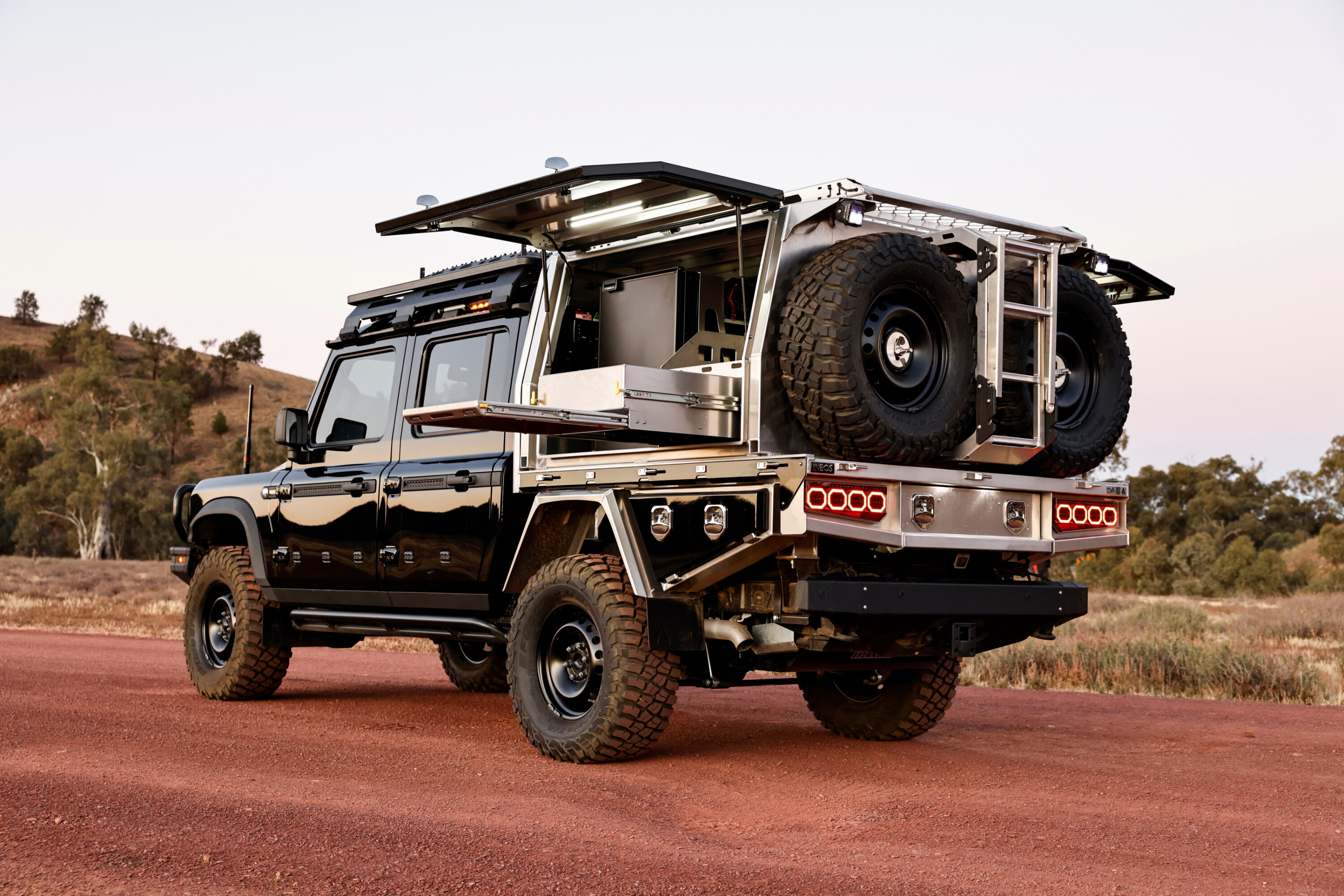
“We wanted to create a truly unique Quartermaster together with some incredibly innovative local engineering and accessory partners,” said Justin Hocevar, Regional Director, APAC at INEOS Automotive. “The Quartermaster Cab Chassis is a ‘blank canvas’ that allows for great versatility when it comes to customisation, so together with these project partners, we let our imagination run wild. Ultimately, the ‘Kaiju Quartermaster’ expresses our Australian vision of ‘built for more’.”
The “Kaiju” – which translates to a mythical ‘giant creature’ or ‘monster’ in Japanese – is based on the Grenadier Trialmaster edition, which means it already comes equipped with front and rear diff locks; raised air intake; an auxiliary battery; 17-inch steel wheels; an access ladder; high load auxiliary switch panel and external plugs; an exterior utility belt and interior utility rails; and a Class III 1-7/8″ NAS tow hitch and electrics. Plus, this one has a selection of genuine INEOS accessories that includes a roo bar, rock sliders and checker plates.
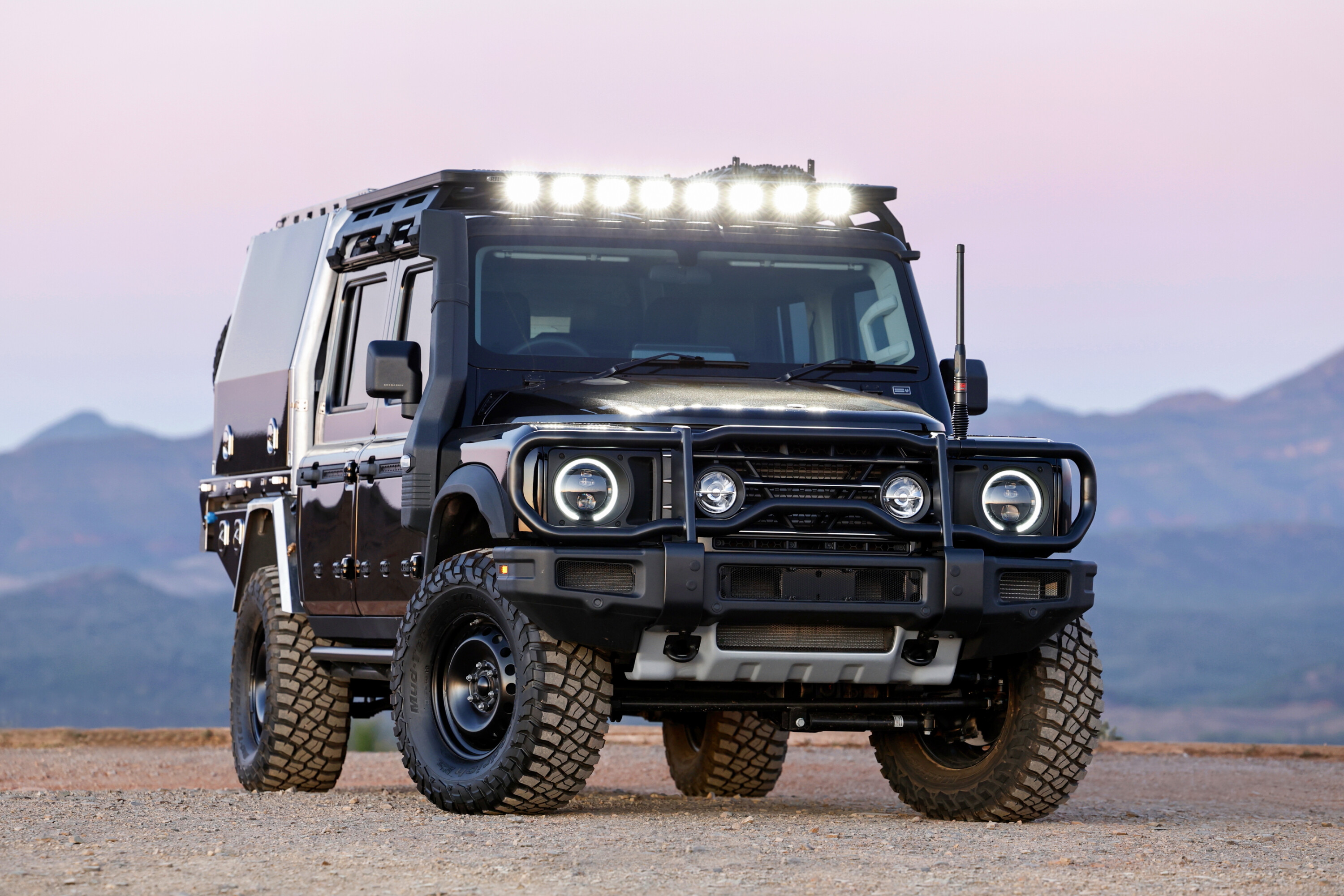
At the rear, Norweld has installed a heavy duty aluminium tray equipped with a 1200mm trundle drawer set-up with a drop-in table. The tray also features an integrated 40-litre poly water tank, as well as exclusive sequential tail-lights. A Compact Deluxe Lite canopy sits atop the tray and is loaded with a 130-litre Bushman fridge and a Bolt-On jerry can holder. Both the canopy and tray are dust- and water-resistant.
Power needs are covered by a suite of REDARC gear including a 2000W RS3 inverter; Manager Alpha50 battery management system; and the addition of an Alpha150 150A lithium battery. An XRS-660 handheld UHF CB radio, XRS-370C4P compact UHF CB radio, and a heavy duty radome UHF antenna and bull bar bracket from GME will keep all comms humming nicely when (if) beyond the black stump.
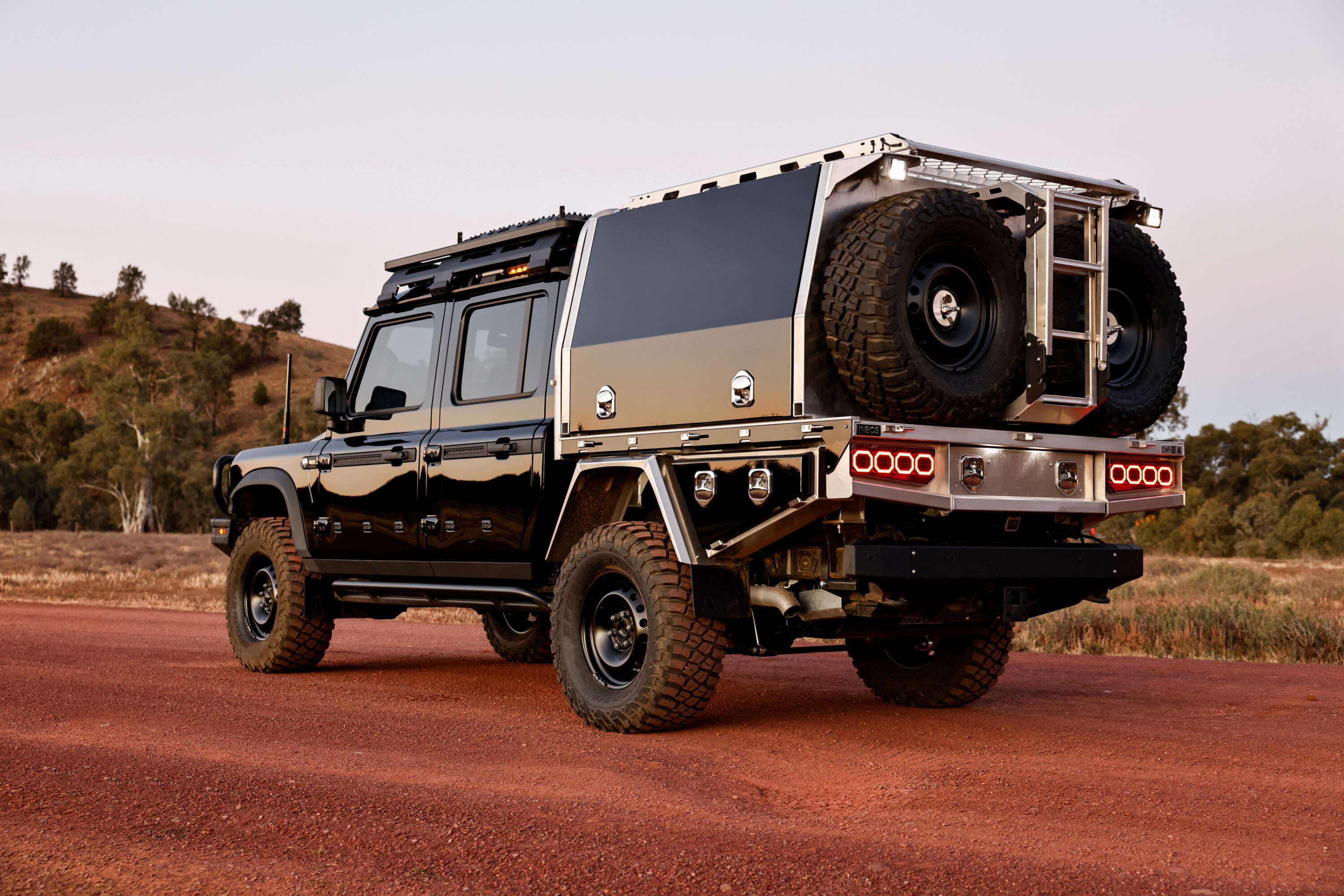
Other kit includes a 168-litre Brown Davis long-range fuel tank kit; a suite of LEDs, wiring and harnesses from STEDI; MAXTRAX recovery equipment; 315/70 R17 KM3 muddies; and the stock suspension was overhauled in favour of high-quality JMACX Alpha remote reservoir electric 2.5 shocks.
When ordered through retailers, INEOS extends the vehicle’s warranty to cover select aftermarket components from official accessories partners.
In a recent post on his Instagram page, Portelli shared a handful of photos of the newly transformed Jeep, and Patriot Campers seemed to have spared no expense for this one-off build.
“So we been keeping this one under wraps for a couple months,” PatriotGamesTV posted to Instagram. “@adrian_portelli asked us to build him a SEMA style Jeep, so that’s what we did!”
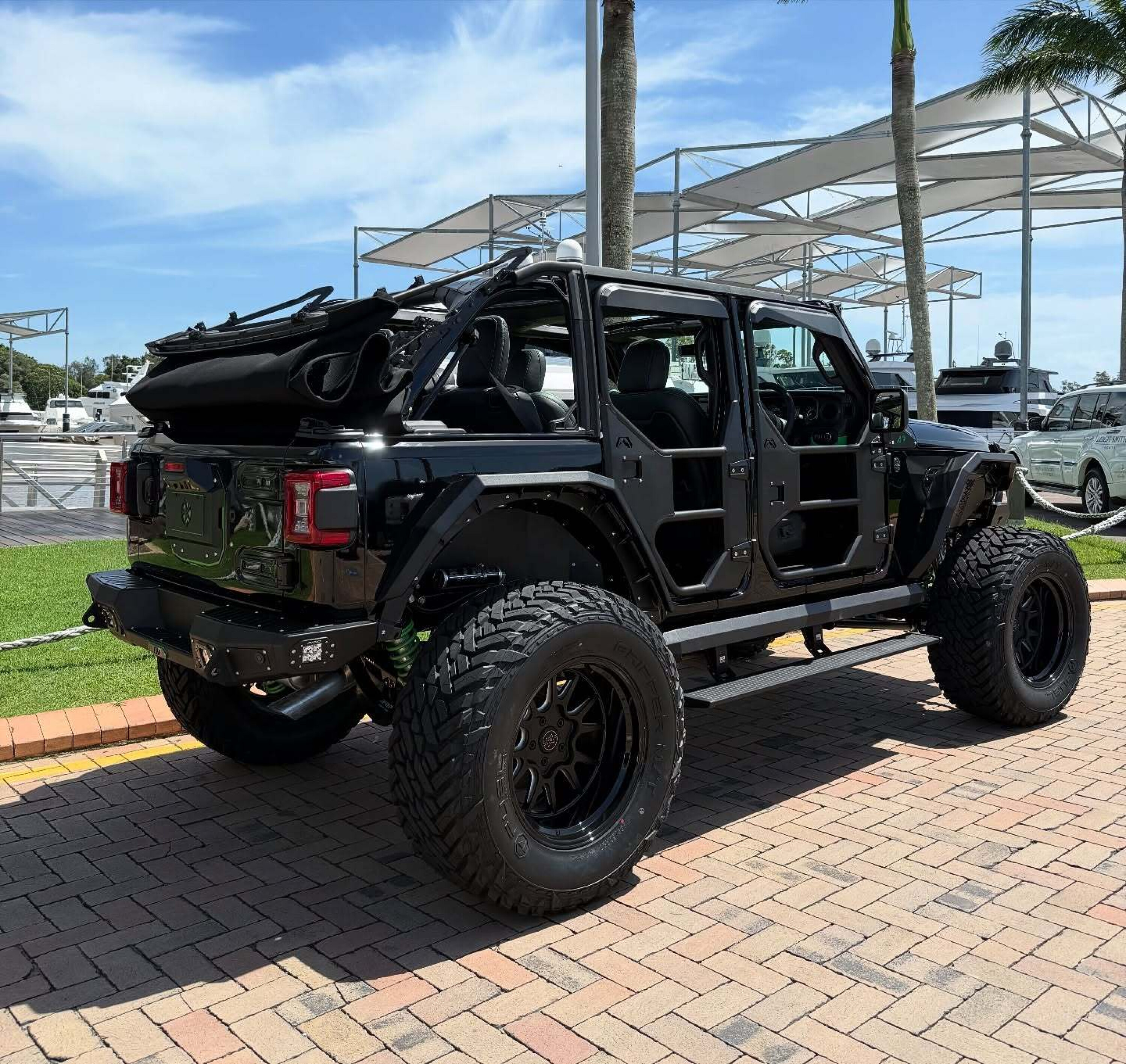
Image credit: instagram.com/adrian_portelli/
The aggressive Wrangler now features tube doors for both the front and rear, as well as an open-air roof with a retractable soft-top that has four slimline LEDs positioned aft. A neat slimline snorkel wears AP nomenclature – Adrian Portelli – as does the front number plate that sits below a bullbar/winch combo.
Gigantic wheels and Fuel Off-Road Gripper tyres are hiding a ridiculous suspension system. We’ll have to wait and see as more info drip-feeds on social media, so we’re not sure whether a HEMI V8 is lurking under the bonnet. However, we reckon they probably would’ve mentioned it in the post if it is.
Animal strikes, stones rocks and scrub are all out there to clash with your vehicle, be they bouncing out in front of you, sliding down the side of your guard or scraping under your sills or sump; there’s always the potential for damage and sometimes it can leave you stuck, or worse, be life threatening.
Driving in the bush is nothing new for Australians and thankfully we have a buoyant aftermarket industry busily designing and fabricating world-class products to protect our 4x4s and their occupants. For our VDJ79 build we were very happy to team up with the crew at Ironman 4×4 as we know they have all the protection gear we need for the LandCruiser.
In fact, it was actually Ironman’s magazine ads featuring a white facelift-model 79 just like ours that convinced us that was the gear we were after, as not only is it well-engineered but it has the desired look.
The equipment fitted to the front of the Ironman LandCruiser, and now on our one, consists of a new Apex bull bar which was specifically developed for the facelifted 2024 70 Series Cruiser; premium steel side steps/sliders with side rails; a Frontier 12,000lb winch; Cube lights in the bull bar that replace the factory fog lights; and a pair of Ironman Scope nine-inch LED driving lights.
It’s a comprehensive package that will protect the front and sides of our Cruiser as well as supply much needed recovery equipment for getting ourselves and others out of sticky situations.
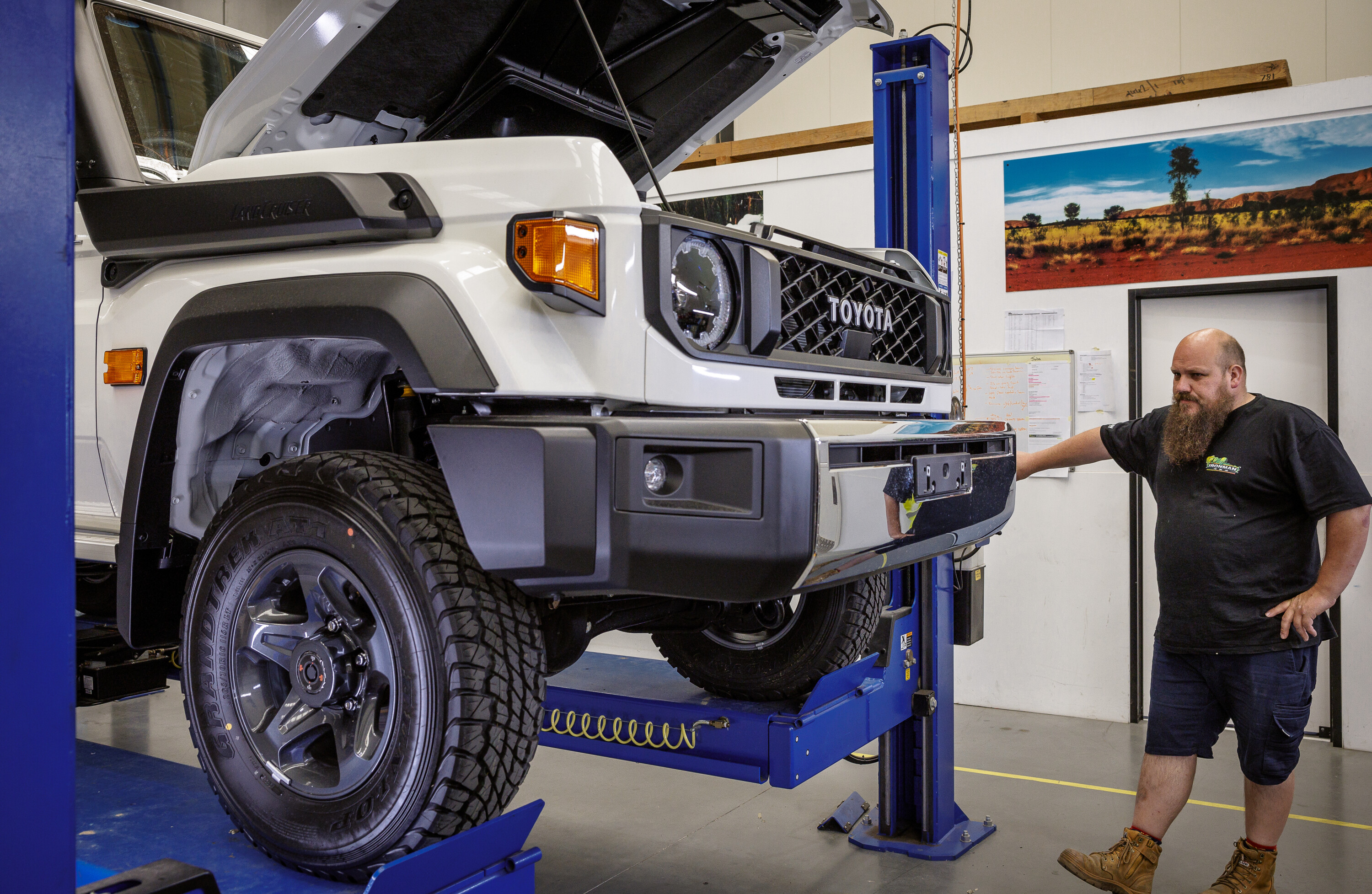
The facelift on the 2024 70 Series LandCruiser is a bit of a back to the future change with a return to round headlights, but they are now LED units with daytime running lights, and there are a few other design elements and vents that hark back to LandCruisers of old. It might be new for this year but the overall front-end of the vehicle remains essentially the same, just revised.
So when it came to creating the Apex bull bar, the design team at Ironman didn’t need to stray too far from what they already had. The full hoop bar is taller in line with the higher bonnet, and the hoops are made big with 63.3mm tube and a more detailed lower channel section with provisions for the latest LED cube lights for the purposes of park and turn signals, fog lamps and additional lighting.
Of course, the Apex bull bar includes a cradle to mount a winch on, and in this case we’ve fitted Ironman’s Frontier 12,000lb unit. Another new product to Ironman 4×4, the Frontier takes over from the Monster range of winches that the company has sold in the past.
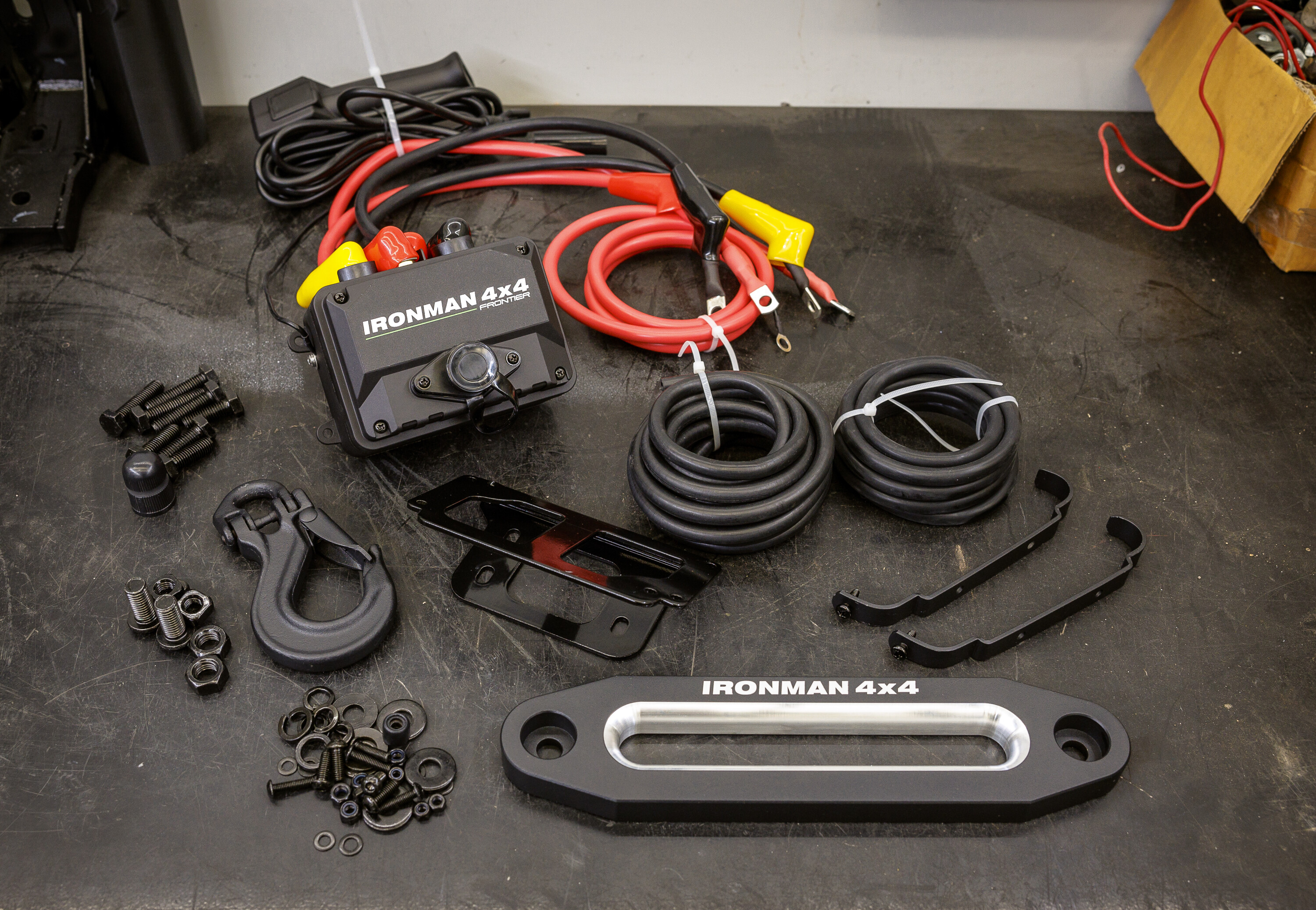
The Frontier takes lessons learned from that experience and the new winch is rated to IP68 for being submersible to one metre for 30 minutes, and it has a breather to allow the heat that builds up out of the housing while keeping water out, thus protecting the internals. This durability allows Ironman to offer a five-year mechanical warranty on the Frontier winch.
The motor is a proven 6hp unit and there is now a controller that can be used either wirelessly or with the supplied cable. We chose the option of synthetic winch rope as it is lighter than steel cable, meaning less weight over the front axle. Synthetic rope is also easier and safer to work with when performing vehicle recoveries.
Fitting the Frontier winch in the Apex bull bar required the winch housing to be ‘clocked’ to get the clutch release lever closer to the front where it is easy to reach. Clocking is simply a matter of undoing the housing and turning it around until the lever is in the best position before buttoning it back up.
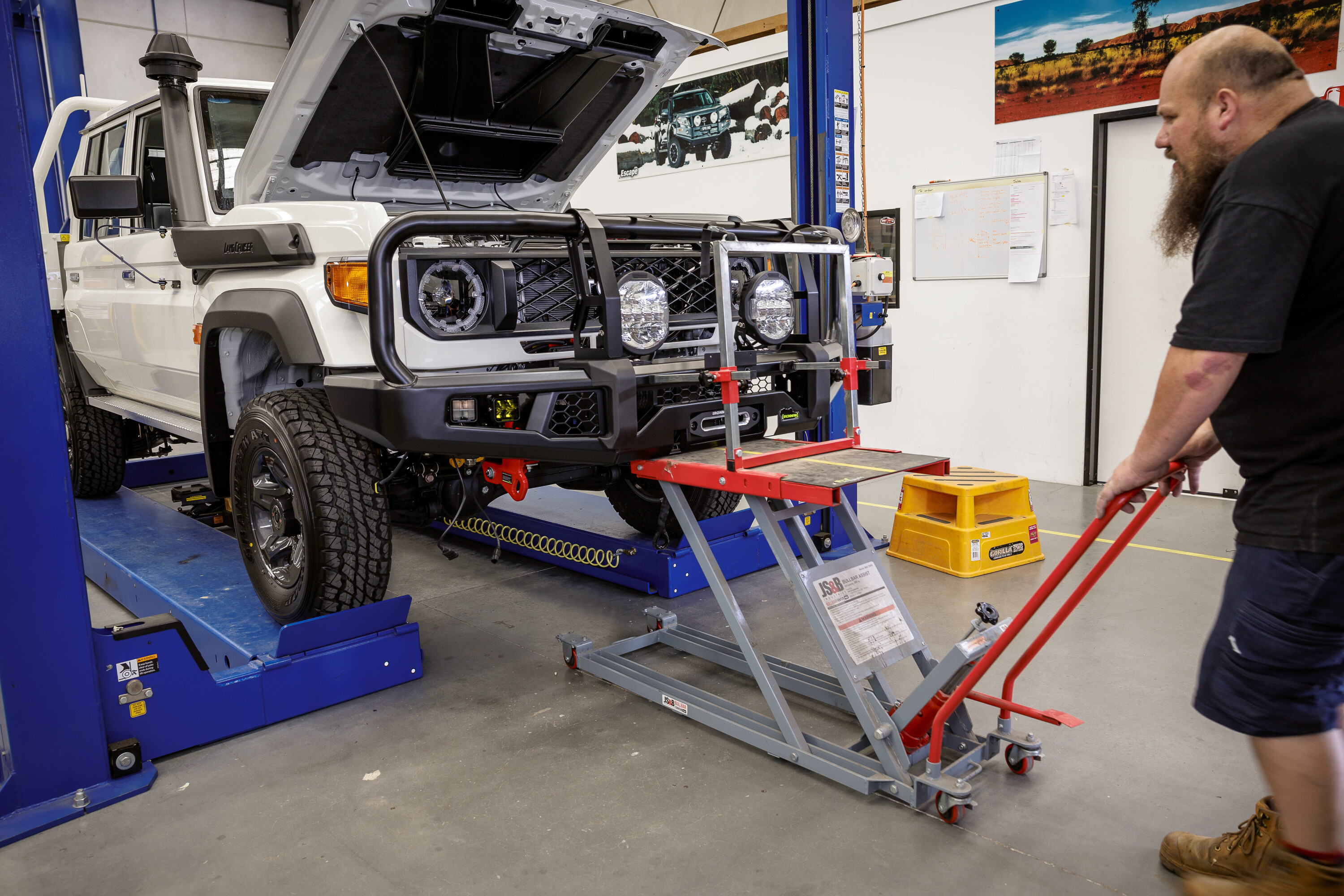
The Apex bull bar has provisions for mounting extra lights on the main channel and antenna tabs up on the hoop. We particularly like that the antenna tabs are at the furthest reaches of the hoops to get the antennas as far out of the driver’s line of sight as possible. There’s also a pair of rated recovery points under the bar along with a 4mm-thick protective bash plate.
The Ironman Scope nine-inch driving lights are a premium product, but at $349 each they don’t come with a premium price tag. The Scope lights are an all-in-one lighting solution as they have two modes for output so that you can dim them down when you have reflective signs on the road and they are a spot and spread combo. In addition, the side lights work as DRL/positional lights when the spotties aren’t in use. The driver can adjust from the full beam to the 80-per-cent dimmer mode via a two-way switch; in our LandCruiser we have mounted this switch in one of the factory blanks on the dash.
At full power the Scope lights punch out up to 1 lux at 1770m, and with a 5700K colour rating the light is claimed to be easy on the eyes. We’ll bring you a full review of the Scope lights and the Frontier winch once we get out in the bush for some night driving.
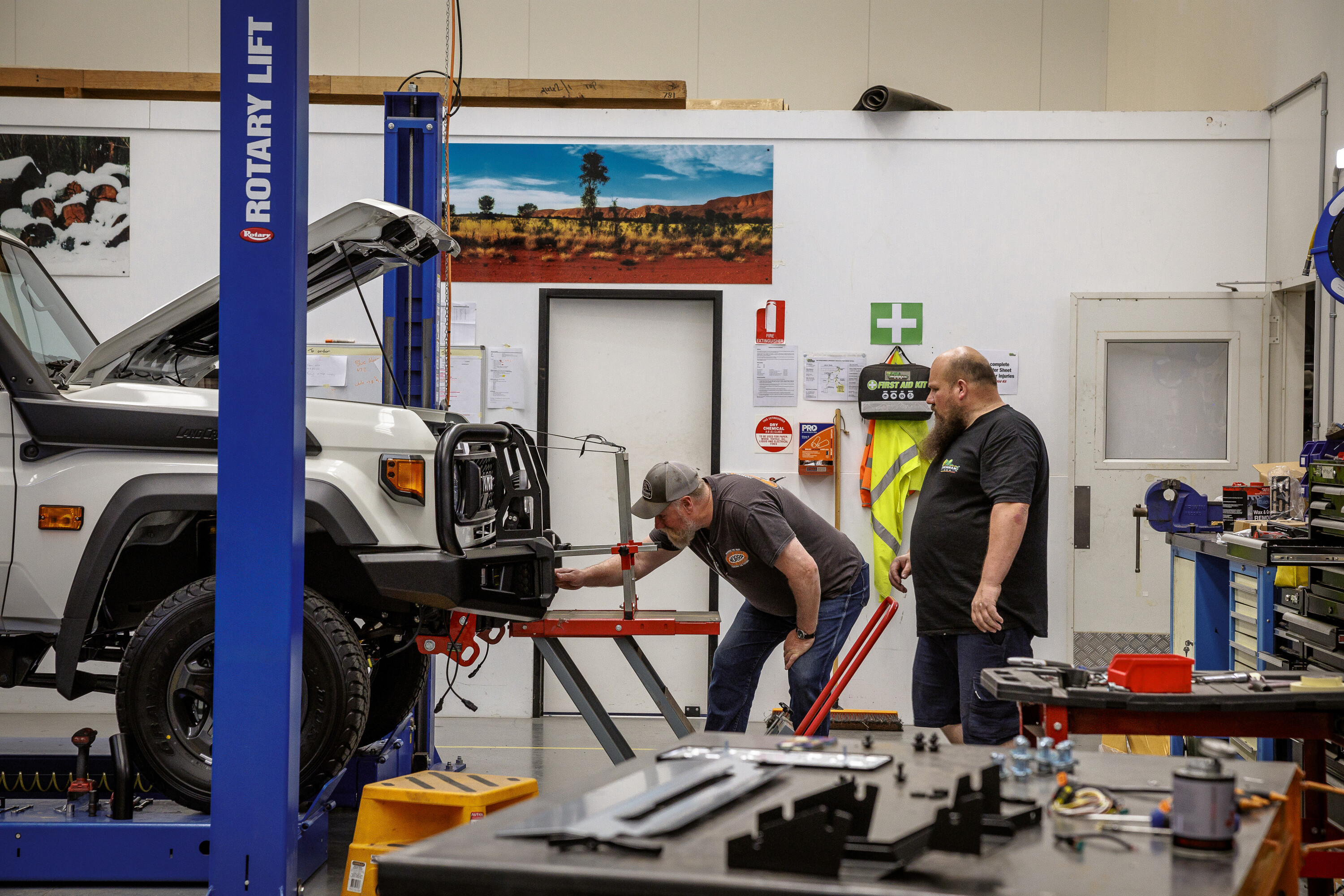
We’ve run a set of Ironman side rails back from the hoops on the Apex bar and down to the side steps. Side rails not only protect the front guards from rubs and scrapes but they also brace the bull bar in the case of a heavy animal strike. As the side steps are mounted to the chassis rails, the side bars triangulate the mounting of the bull bar for greater strength in an impact.
The standard aluminium side steps Toyota fits are as consumable as brake pads and tyres; one decent scrape on a rock or log and they are easily busted up, so steel replacements are always a worthy addition. Ironman’s Premium side steps not only give folks an easy step up to get in and out of the cabin but add valuable protection to the sills and side of the vehicle; like a bull bar and side rails, they provide peace of mind when you are driving in the rough stuff.
The Ironman 4×4 kit comprising the Apex bull bar, side rails, Premium side steps, Frontier winch and Scope lights has given our LandCruiser a comprehensive package of vehicle protection, self-recovery capability and forward lighting, all things we’d recommend for any 4×4 vehicle heading bush… and that’s just what we’re planning to do.
Predator Tyres recently launched a range of all-terrain (AT) and mud-terrain (MT) tyres in various sizes to gauge the Australian market, with more sizes coming soon, so I thought I’d give them a go.
Predator, you ask? Parent company ROH Wheels saw an opening in the market to launch these new tyres for Aussie adventurers. ROH has been making wheels for a huge range of vehicles worldwide since the early 1940s, including OEM rims, and before dipping its toe into the tyre market the company tested several brands before settling on the Chinese-made Predator tyres.
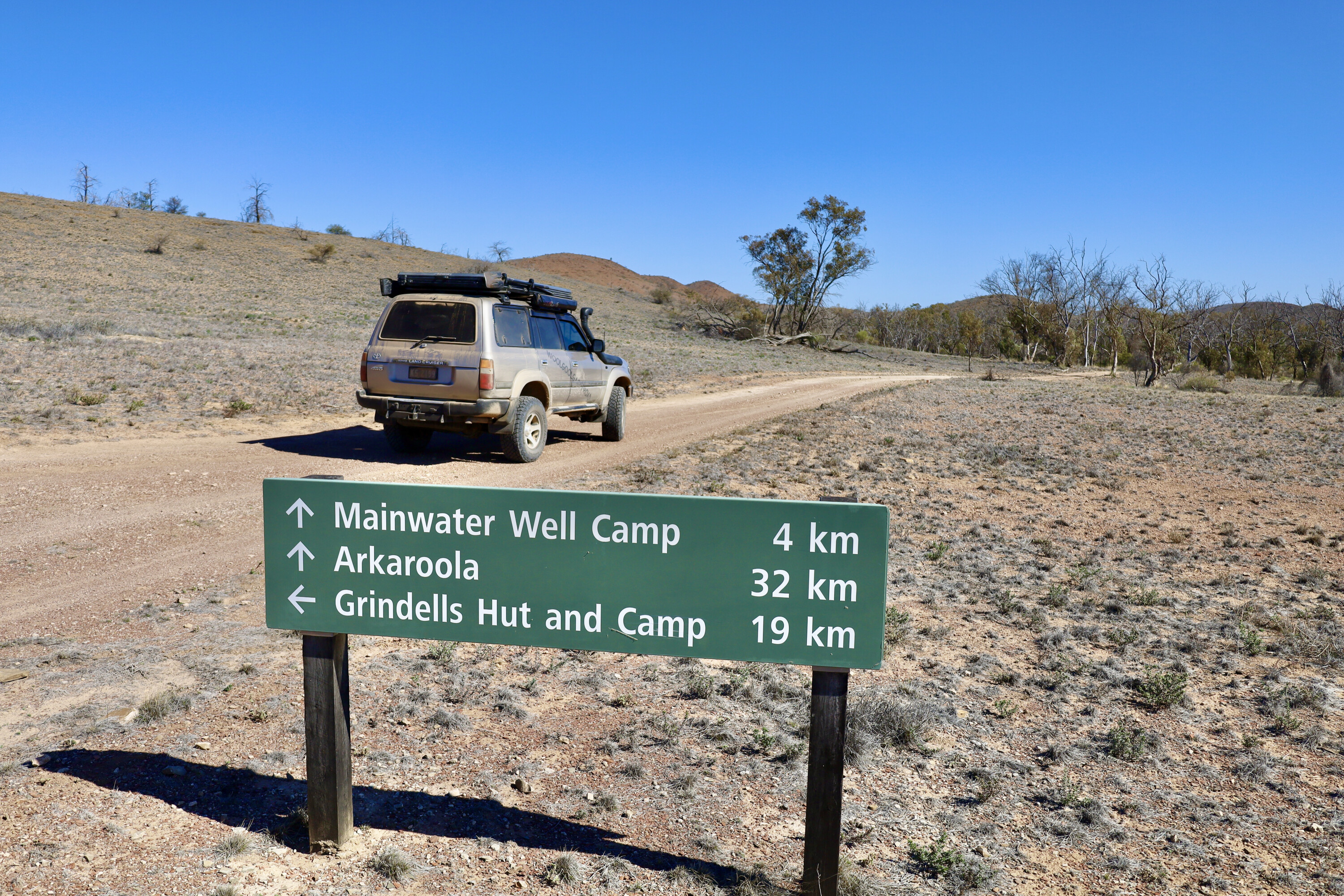
It features an advanced X-tread pattern with dual sidewall protection for sticky mud situations where you need all the traction you can get. At the moment the MT’s are only available in three 17-inch sizes but according to ROH more sizes will be added as demand increases.
The New Mutant X-AT tyre is available in 15-inch up to 18-inch sizes, and this is what I opted for on my LandCruiser, in an LT285/75R16 size, and after six months I am suitably impressed with their performance. At first I was hesitant that they didn’t look like an aggressive AT tyre, and I wondered how they would perform in outback conditions, but with nearly 20,000km on them I have become a fan.
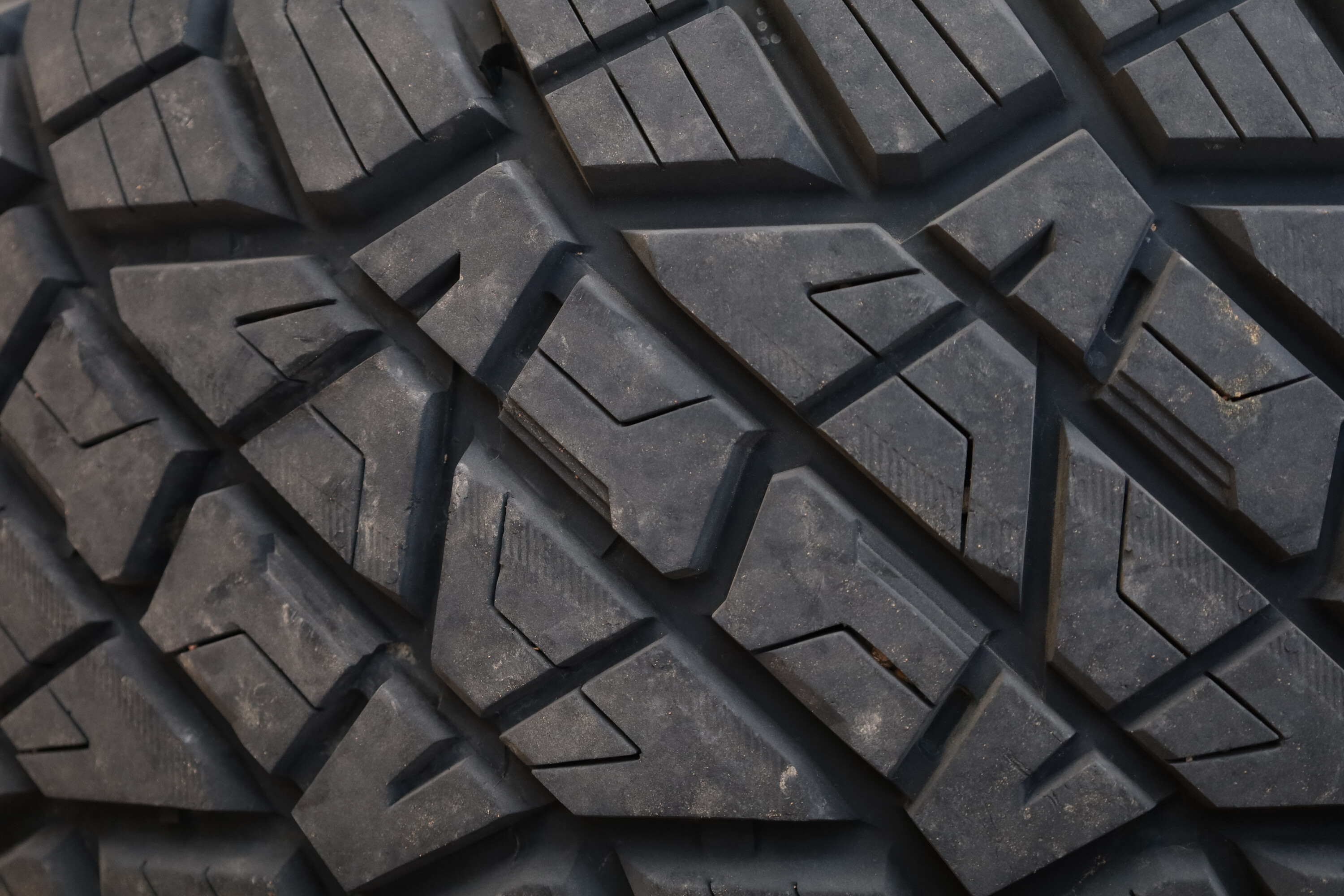
So far I’ve tested the X-ATs on some pretty remote outback roads where they have again proven to be quiet on dirt and rock surfaces, and they do a good job of flicking away stones that can get caught up in the tread blocks of some other tyres I have tested.
Like the X-MTs, the New Mutant X-ATs also run an X-tread pattern, and they have a ‘Spike’ dual sidewall design.
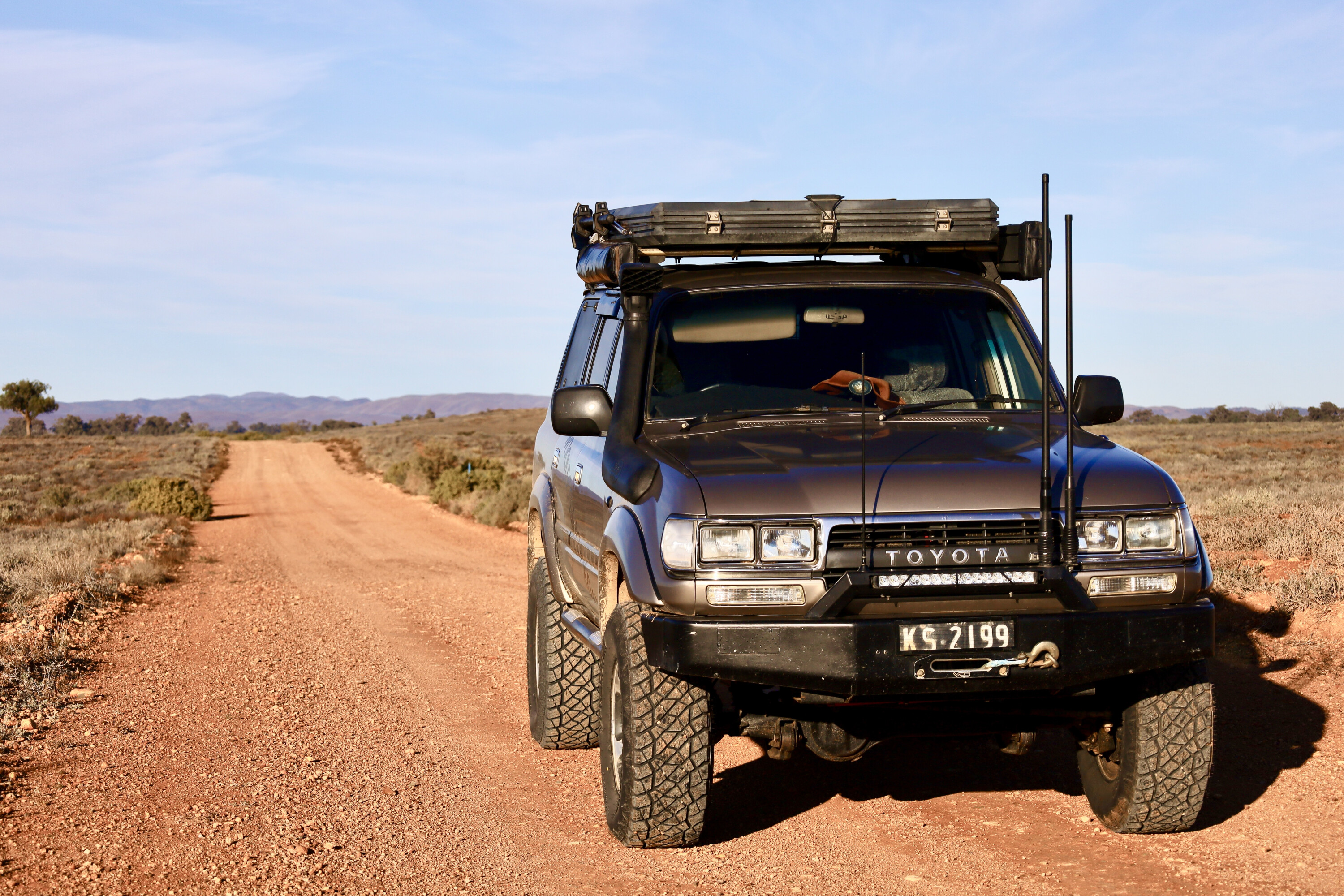
When driving through the harsh rocky terrain of the northern Flinders Ranges these tyres really showed their worth; despite the sharp, shaley rocks with jagged edges, the tyres with their 10-ply sidewalls and deep, aggressive X-tread saw them ease through every track I tackled.
Predator claims the New Mutant X-AT has an advanced tread compound for long-lasting wear and optimum traction. The tyre is covered by a four-year manufacturer’s warranty and an 80,000km tread life warranty, so long as certain conditions are met that can be found on the Predator website.
RRP: Contact Predator Tyres for price
AVAILABLE FROM: www.predatortyres.com.au
WE SAY: A new tyre to the market but one that is so far proving to offer a good blend of on- and off-road performance.
Dubbed the HiLux Rangga in Indonesia, the vehicle is based on the highly customisable Toyota HiLux Champ, a budget-friendly cab-chassis that came to market in 2023.
Riding on a ladder-frame chassis, the SUV made its public debut earlier this year at the GAIKINDO Indonesia International Auto Show (GIIAS) – but these photos recently published to social media have brought it back into the limelight.
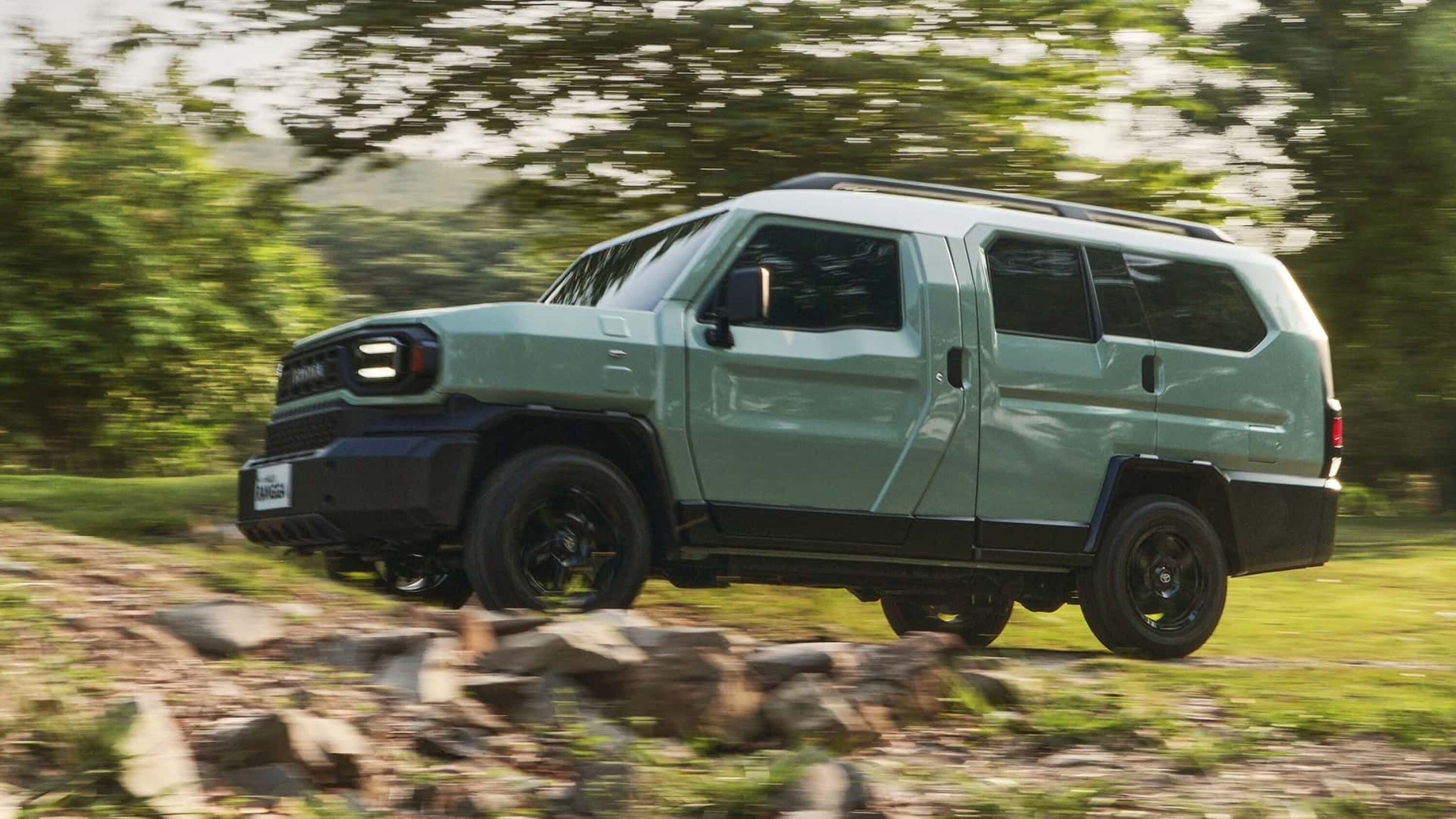
Local Indonesian upfitter – New Armada – has transformed the SUV from the B-pillar and beyond, essentially leaving the front-end untouched. This means it features a 2+3+2 configuration in the now-enclosed cabin. RANGGA lettering is plastered on the big tailgate, surrounded by vertically mounted tail-lights.
In Indonesia, it’s available with either a 102kW 2.0-litre petrol engine or a 110kW 2.4-litre turbo-diesel engine, mated to either a five-speed manual or a six-speed automatic transmission.
Local reports indicate the Rangga will be priced from 400,000,000 rupiah (petrol version with a manual gearbox) which translates to about $AU40,000.
Yep, the larger, more frequented servos in the cities and towns are less likely to have contaminated fuel, but it’s sure not unheard of for water or contaminants to find their way into busy servo tanks at times. Having said that, you are more likely to cop a dose of dirty diesel at the lesser used outback servos and when pumping fuel from drums. For this reason, it’s a wise idea to not only fit a prefilter but also to carry extra filter elements.
Fitting a Flashlube pre-filter kit to any 4×4 ensures your engine will only drink the cleanest fuel possible. The kit includes a diesel fuel filter and water separator in one, utilises a replaceable 30-micron filter, and ensures that neither dirt nor water will pass into your vehicle’s main filter.
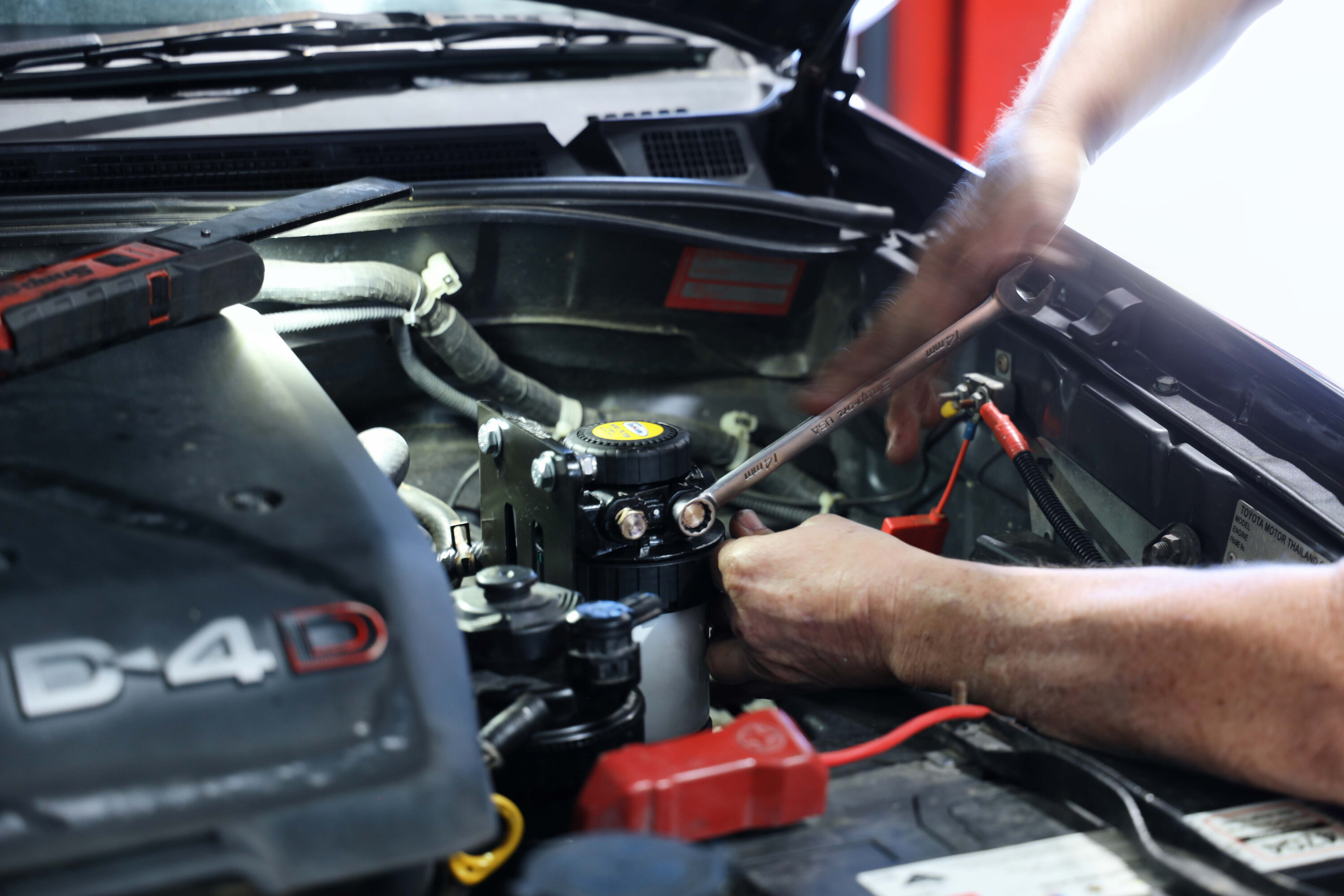
Well, it saved the innards of the Troopy’s fuel pump, fuel lines, injectors, and every other component that the dirty fuel could come into contact with. While it may have only saved the mechanicals once over 10 years and over 100,000km of remote driving, that once was more than enough to pay for itself many times over.
Essentially, the Flashlube kit is an insurance policy, keeping your 4×4 running at its best with clean fuel.
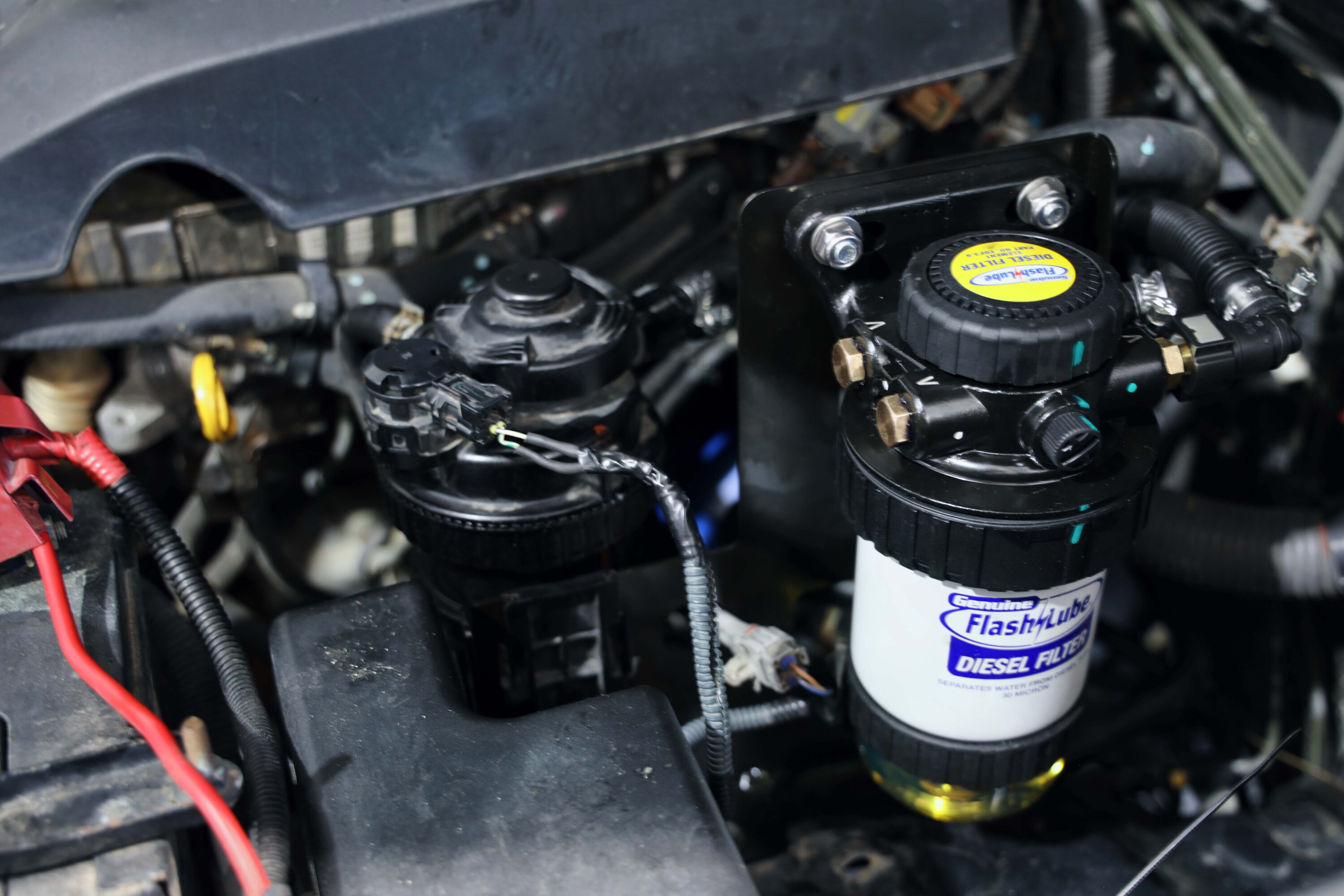
The clear glass bowl at the base of the Flashlube unit allows me to see the general condition of the element. If in doubt or if I’m unsure of its cleanliness, I renew the filter just to be on the safe side.
Given that the Flashlube kit filters the fuel before the OE primary filter, that factory-fitted unit will stay cleaner longer. It will still have all factory warnings and sensors intact and ready to beep, flash or buzz if it becomes contaminated in any way. The micron of the Flashlube filter is not so fine as to slow the flow of diesel but it’s fine enough to filter the gunk from the fuel as needed.
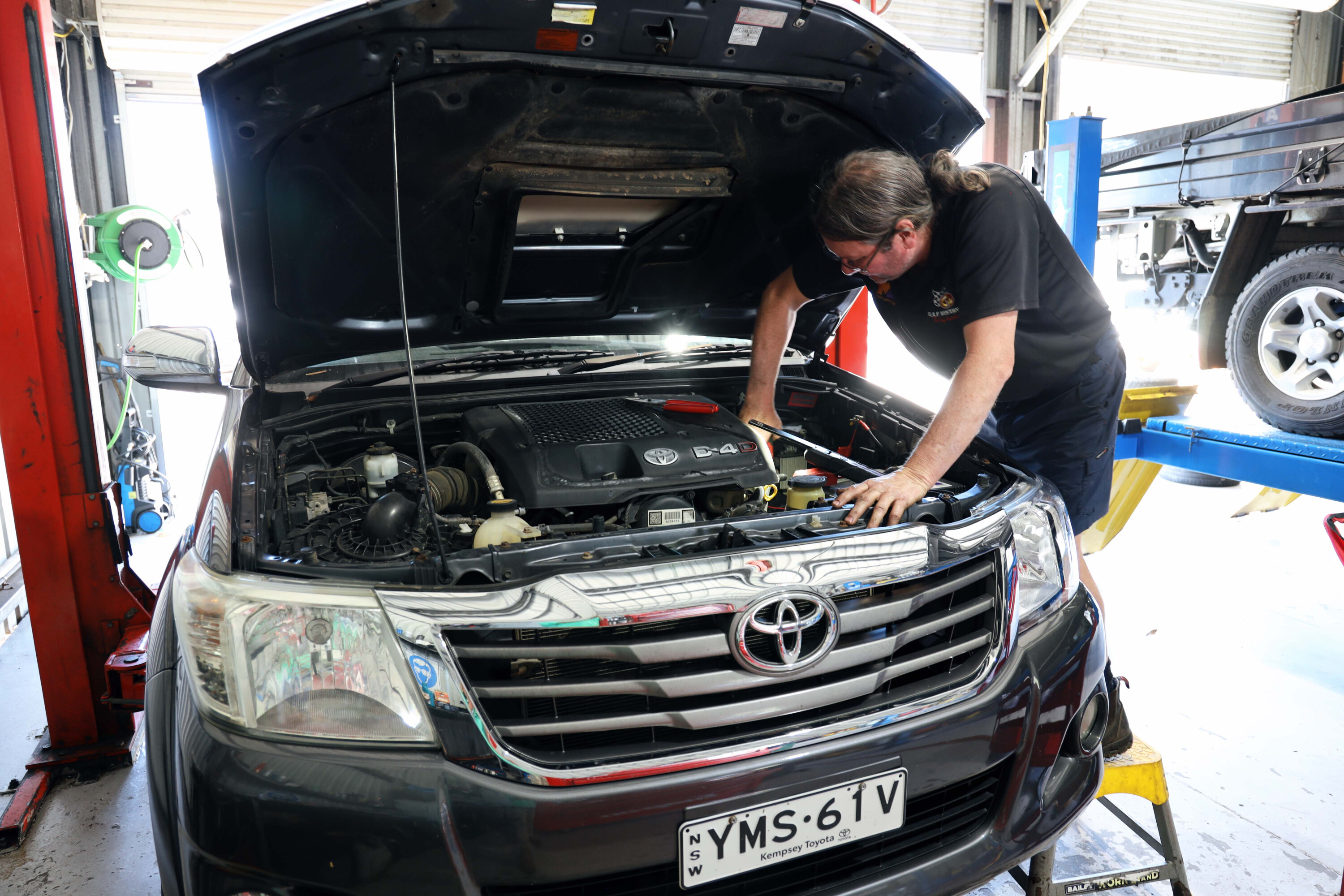
Installation into the HiLux was a breeze, and I’m confident that I won’t be left stranded with a clogged main filter or suffer internal mechanical failures from contaminated fuel. That’s an insurance policy that I’m happy to dish out for.
RRP: POA
AVAILABLE FROM: www.flashlube.com
WE SAY: Easy to install and invaluable insurance for your vehicle’s diesel engine.
Across the four key criteria the Prado received scores of 85 per cent for Adult Occupant Protection; 89 per cent for Child Occupant Protection; 84 per cent for Vulnerable Road User Protection; and 82% for Safety Assist.
“The new Toyota Prado delivers a robust level of safety that aligns with the expectations of fleet buyers and everyday consumers. This is yet another strong result with the new generation Prado demonstrating Toyota’s continued focus on safety across its model line-up,” said ANCAP Chief Executive Officer, Carla Hoorweg.
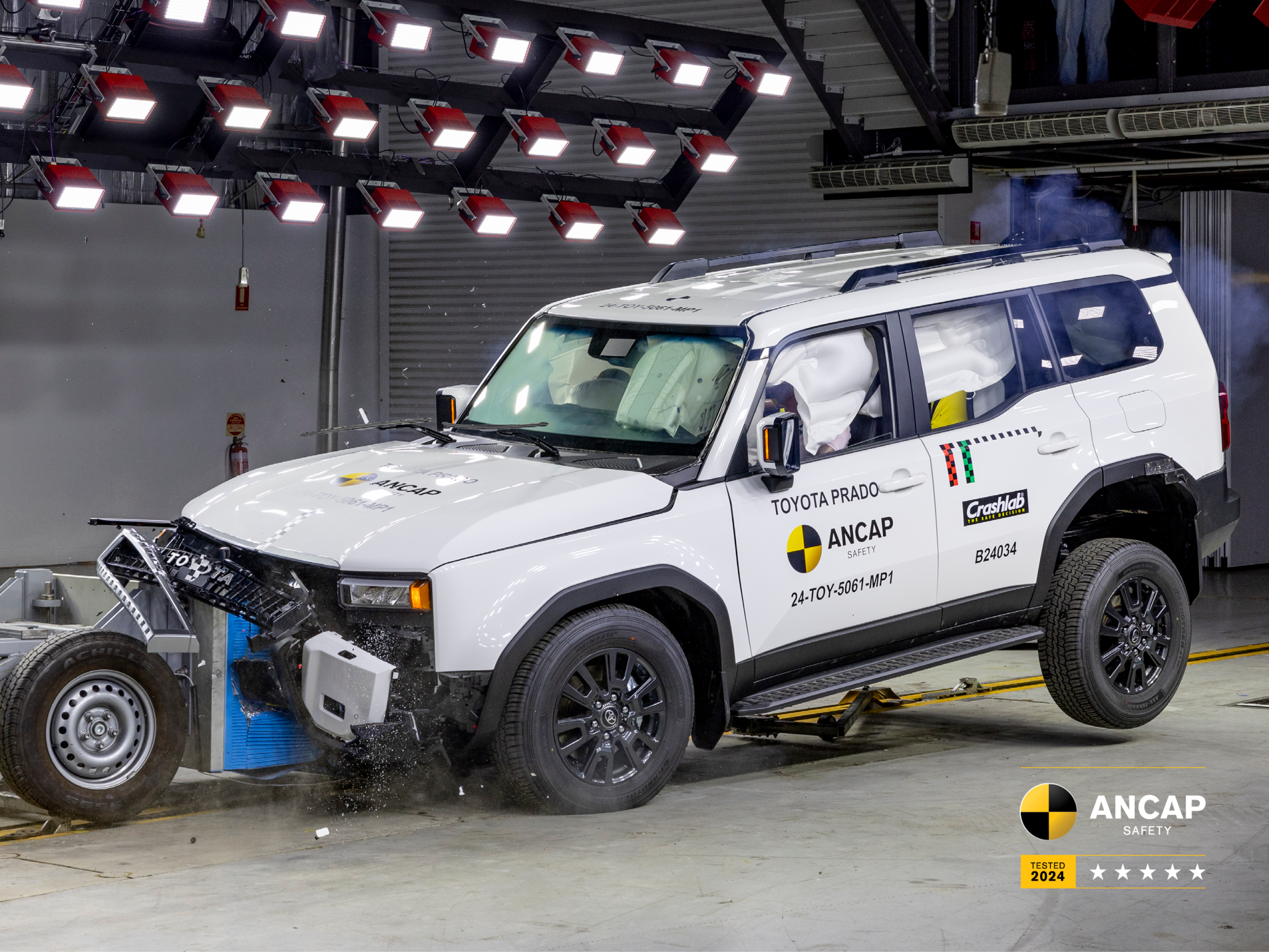
The Prado only showed ‘marginal’ protection of the driver’s chest during the frontal offset head-on crash test (50km/h) and ‘adequate’ protection of the lower legs. However, the Prado did score maximum points during the Child Occupant Protection frontal offset and side impact tests, which uses six-and 10-year dummies.
The large SUV features dual frontal, chest, side head, centre, driver knee and passenger knee airbags, as well as a full suite of advanced safety tech including autonomous emergency braking; lane support system (LSS) with lane keep assist (LKA) and emergency lane keeping (ELK) functionality; blind spot monitoring (BSM); and autonomous emergency braking.
Toyota shifted a total of 3590 Prados to customers in its first official month on sale in Australia, making it the second best-selling vehicle in the country behind only the Ford Ranger.
Initially only offered in the one specification level, the Tundra Limited, it will be joined by a higher spec Platinum model later in 2025. That’s not to say that the Tundra Limited is not highly specified, and so it should be after arriving with a price of $155,990 plus on road costs into a full-size pickup market that is growing and becoming more competitive.
RAM, Chevrolet and Ford are already battling it out in the US truck segment but they will be joined by outsiders from China with new offerings growing beyond the more popular midsize utes that dominate the Australian light-truck market.
What the Tundra does bring to the segment, which none of its American cousins do, is a proper hybrid powertrain. Sure, the V8 Ram has a 48-volt mild-hybrid system but that doesn’t really count and it will be replaced early in 2026 with a new drive unit. When the RAM get’s its all new inline six-cylinder engine it will leave the Chevy Silverado as the only V8-powered truck in the 1500 class.
The iFORCE MAX that powers the Tundra is a 3.5L V6 twin-turbo petrol engine that produces a claimed 290kW and 649Nm on its own, but paired with the parallel hybrid system, peak output jumps to a claimed 326kW and 790Nm, endowing the Toyota Tundra with the most grunt in the segment. The hybrid system charges a 288v NiMH battery that feeds a motor-generator that sits in the bell housing of the 10-speed automatic transmission.
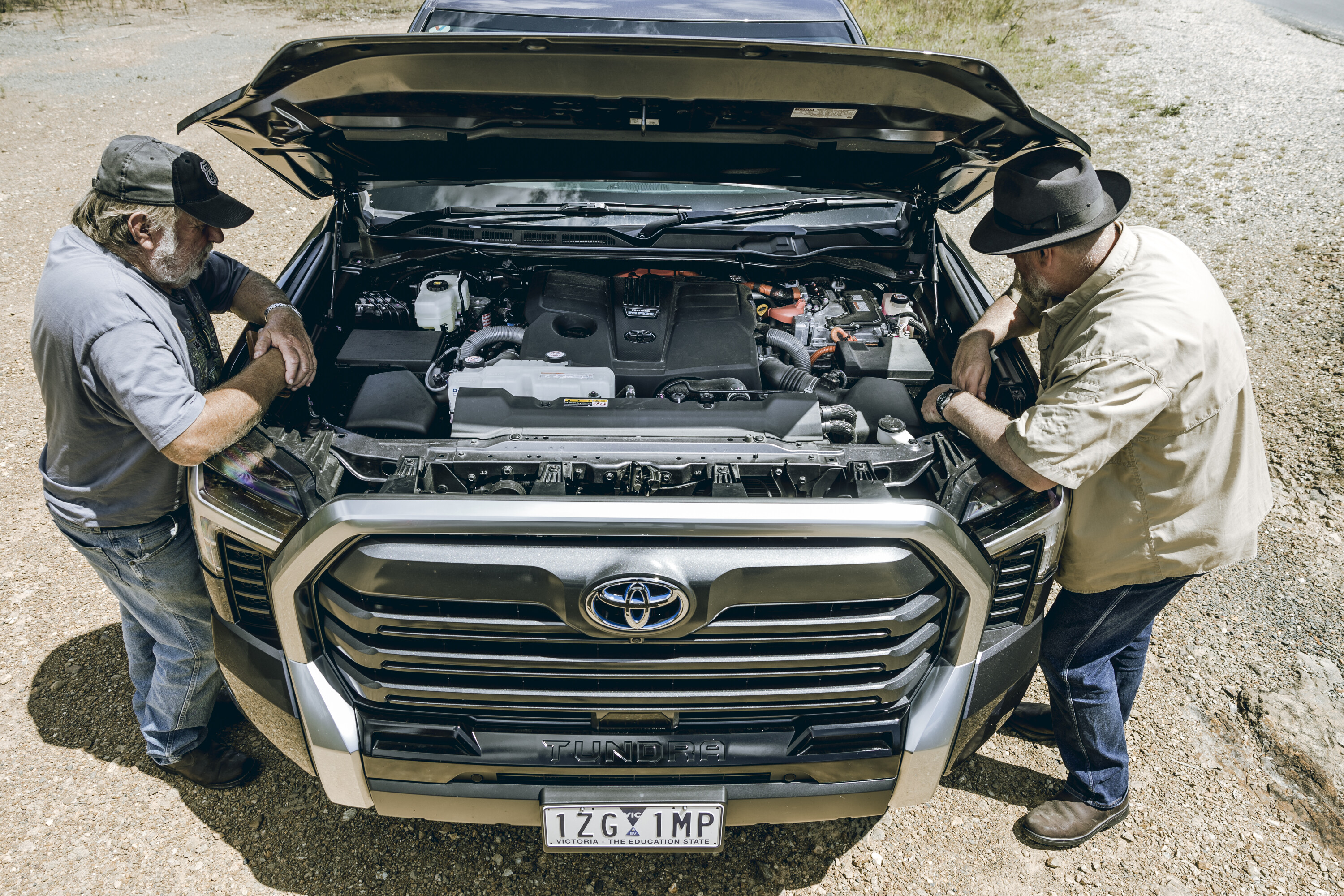
Interestingly, the Tundra only has a part-time transfer case so there’s no full-time 4×4 for on-road use but it does have high and low range 4×4 for loose surfaces and off-road use. Past experience has shown us that trying to put such high torque-loads through the rear wheels on a greasy surface when towing a three-tonne or heavier trailer can be sketchy, and that’s where full-time 4×4 comes into its own, as well as on gravel tracks.
Inside the Tundra Limited you will find faux-leather seats with heating and cooling on the power adjustable front pews, a 12.3-inch digital instrument cluster and a 14-inch multimedia touchscreen with Bluetooth wireless Apple CarPlay and Android Auto pumping sounds through a 12-speaker JBL sound system, along with a wireless phone charger and dual-zone climate control.
For towing loads of up to 4.5-tonnes (with the available heavy duty towing kit; 3.5t standard) there’s an integrated trailer brake controller with an on-screen trailer reversing guide.
Safety kit includes ABS, ESC, lane departure and traction control and warnings, pre-collision AEB system with day/night pedestrian and daytime cyclist detection, rear cross traffic alert and trailer sway control.
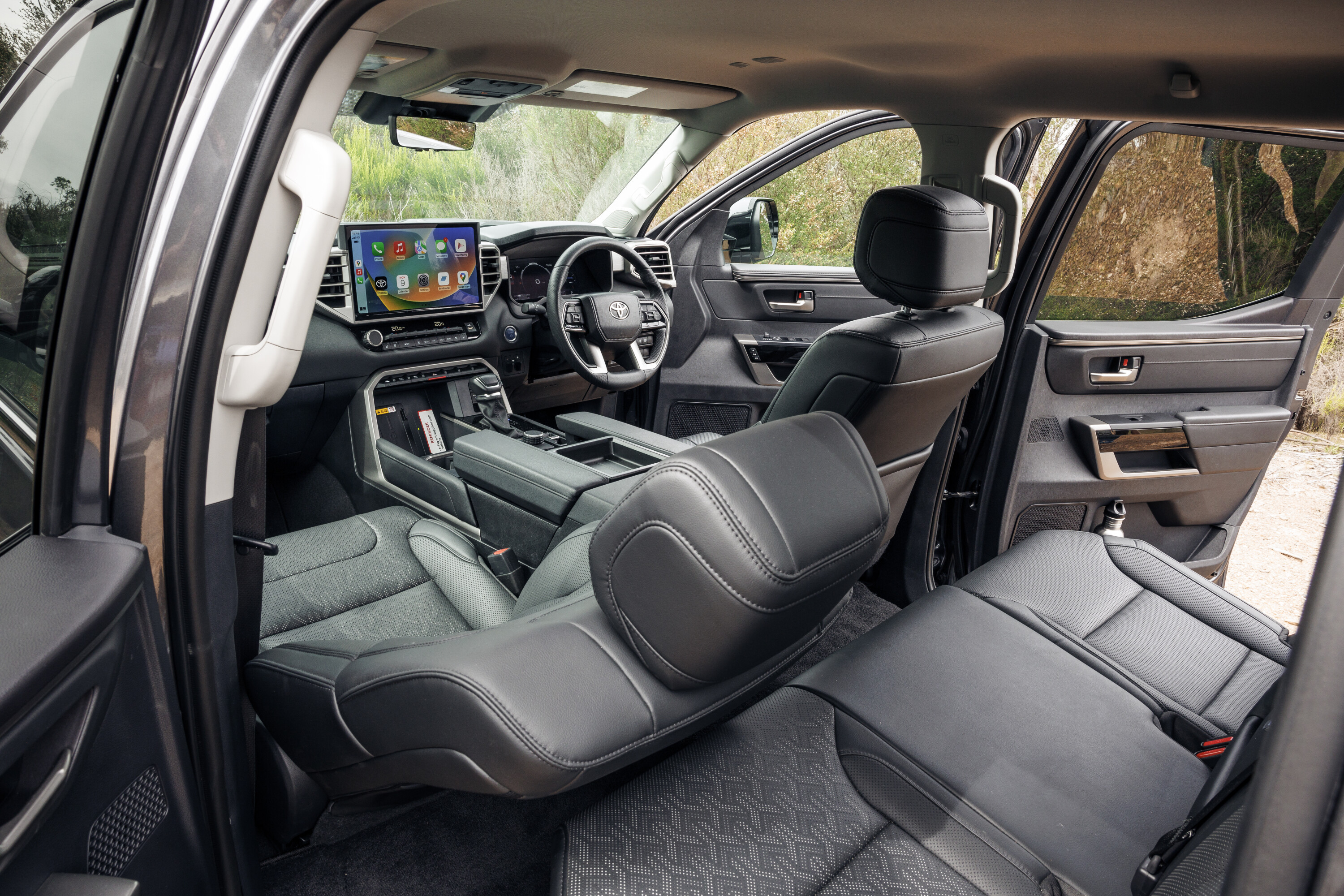
Underpinning the luxury four-door cabin is Toyota’s TNGA-F chassis platform as found under the LandCruiser 300 and Prado 250 Series, however under the Tundra its 3700mm wheelbase is a whopping 850mm longer than that of the LandCruiser 300 and the 1737mm wheel track is 70mm wider than the 300. The chassis holds a double-wishbone coil-spring IFS and a multi-link coil-spring live rear axle in place.
The cargo bed has a protective liner, adjustable tie down points and a folding load cover but there are no power outlets or lights in the tub. Fixed tie-down points positioned low in the bedsides supplement the adjustable ones positioned higher up.
Speaking of cargo, the Tundra is only rated for a 758kg payload which seems paltry for a truck of this size, but this is on par with other trucks in the class including the Silverado, RAM 1500 and Ford F-150 models.
All this hardware adds up to a truck that follows the recipe of other full-size trucks from the American Big Three. The large cabin provides ample space for both front- and rear-seat passengers and the rear seat folds up to give more storage space when not in use.
A large glasshouse provides great vision around the vehicle for driver and passengers, and the massive multimedia screen also aids the driver when negotiating tight terrain with views from front and rear cameras.
All of the controls are placed logically in typical Toyota fashion so they are easy to use and operate, and the driver’s seating position is comfortable with plenty of adjustment. The digital dash screen looks like something from the Death Star and is loaded with lots of information; much of it is green coloured to make you feel all warm and fuzzy about saving the planet in your hybrid truck but the display lacks some key info that would actually be useful such as speed sign recognition and a TPMS.
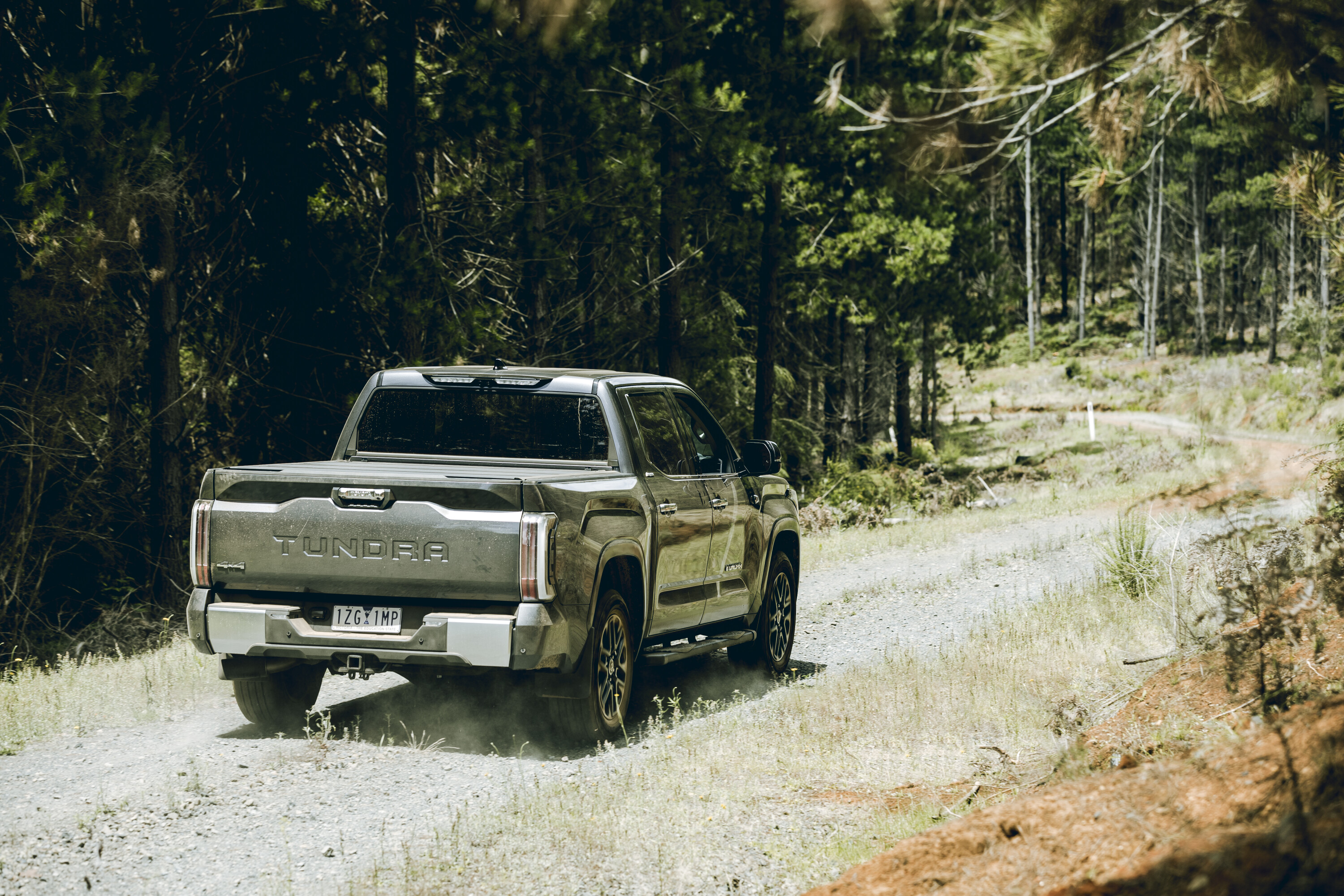
The hybrid iFORCE MAX powertrain puts out a non-offensive growl under full throttle to provide swift acceleration and strong load hauling capability. The 10-speed auto is smooth and precise but you can feel the electric side of the hybrid system cut in when driving.
The drivetrain offers normal, sport and eco modes. Even in the eco mode and when using a light throttle application, the petrol engine still cuts in to move the Tundra, meaning there is no full electric driving.
There is nothing to complain about in the suspension department; it does its job without fuss and the cabin is well insulated from road noise on both sealed and gravel surfaces.
Like the other big pickups out of the US, the Tundra is not a great off-road vehicle in standard trim. It is heavy and low riding, and while good on gravel roads, it’s less than suited to deep ruts and large rocks. The long wheelbase and low ride height results in poor ground clearance when riding on standard suspension, and the Tundra Limited does not come equipped with a locking rear differential.
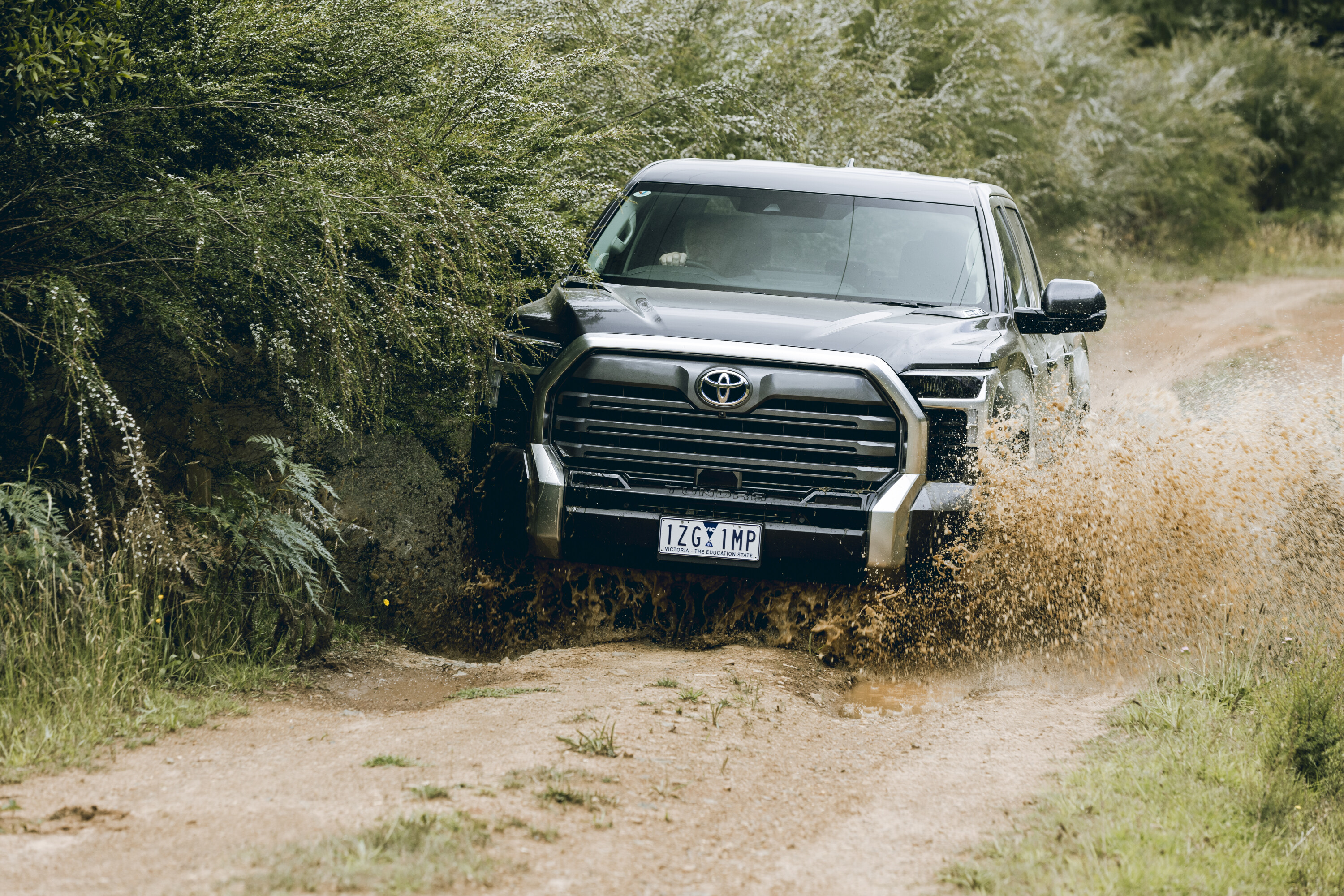
Other Tundra models in the USA are available with an on-demand 4×4 system with multi-terrain monitor and drive modes, but not on the Limited model currently sold here, which is a pity as such a system would be appreciated for towing and when driving on gravel roads where the Tundra is best suited.
There are also several off-road packs available in the US that provide improved suspension but we’ll have to wait until Toyota reveals the specification of a higher-grade Tundra set to launch in Australia in 2025 to see if we get any more off-road hardware from the factory.
| Off-road specs | |
|---|---|
| Approach angle | 23u00b0 |
| Departure angle | 21u00b0 |
| Ground clearance | 216mm |
The re-engineering process for left- to right-hand drive is done in Melbourne by the Walkinshaw Group, which has plenty of experience in this game as it is also the company that does similar work here for both Chevrolet Silverado and RAM trucks. The Toyota Tundra conversion is done at its own facility and there is no sharing between the US truck brands, but the processes are similar.
Bringing the Tundra to Australia has been a six-year process for Toyota with trips to the USA for Australian personnel and key engineers from Japan visiting Australia. This is the first and only program of its kind in the Toyota world in which a vehicle that is made by Toyota America is shipped to another country where it is re-engineered by a third-party manufacturer and then marketed and sold by Toyota Australia.
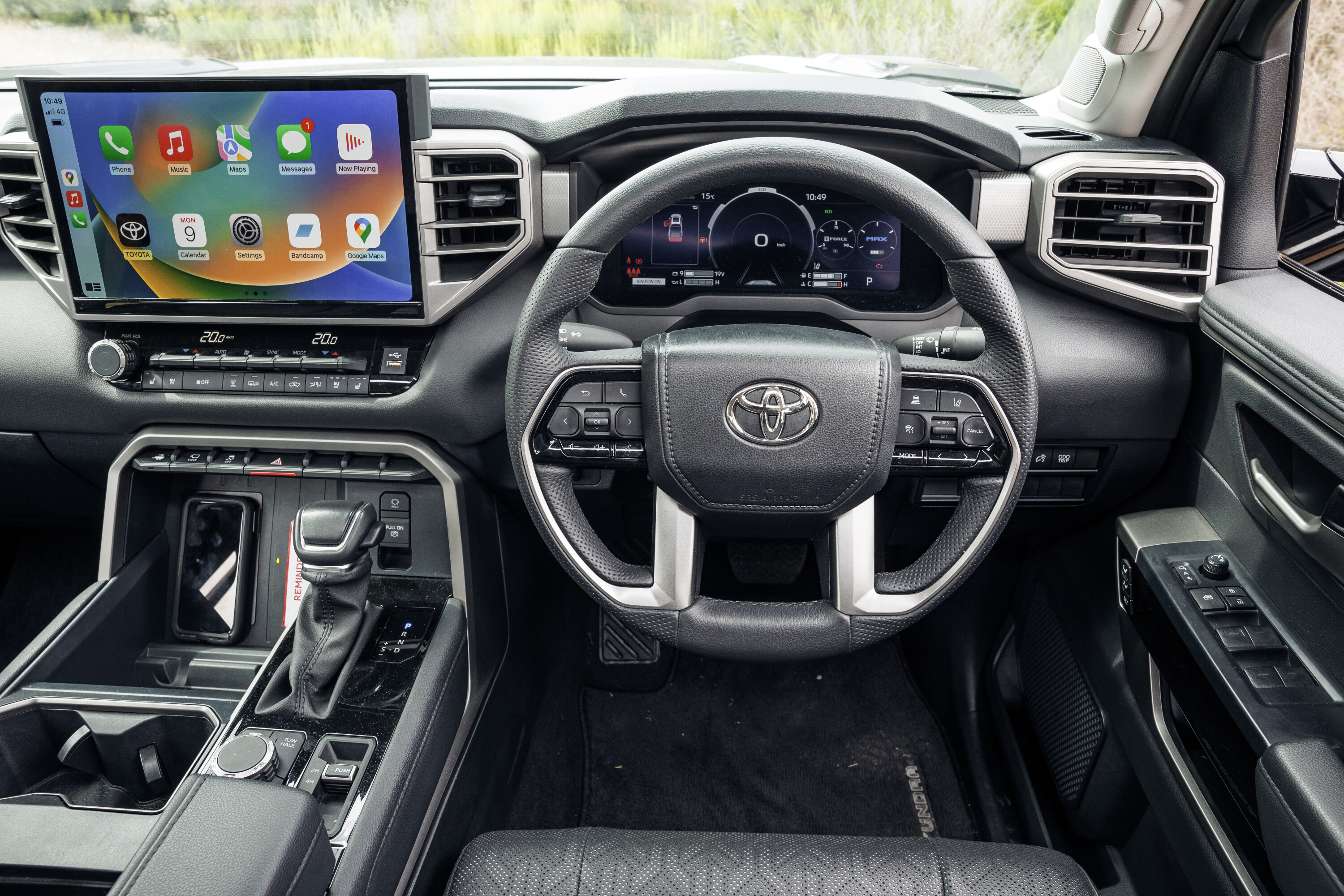
Interestingly, the team working on the Tundra program at Walkinshaw is smattered with former Toyota engineers including some that worked on the left-hand drive Camry program when they were built in Australia and shipped to overseas markets.
The fact that the current Tundra, which was launched in the USA in 2022, shares its platform with the current LandCruiser, certainly made the engineering process easier, but it is still an extensive job. It includes removing the body from the chassis and powertrain and then the two sections each work their way down parallel manufacturing lines where the modifications are made and components replaced, before being reunited and bolted back together before being tested and prepped for sale.
The shared TNGA-F platform allows the sharing of some RHD components such as the steering rack, pedal mountings and HVAC blower fan, which are taken from RHD LC300 and Lexus LX models that have the corresponding parts.
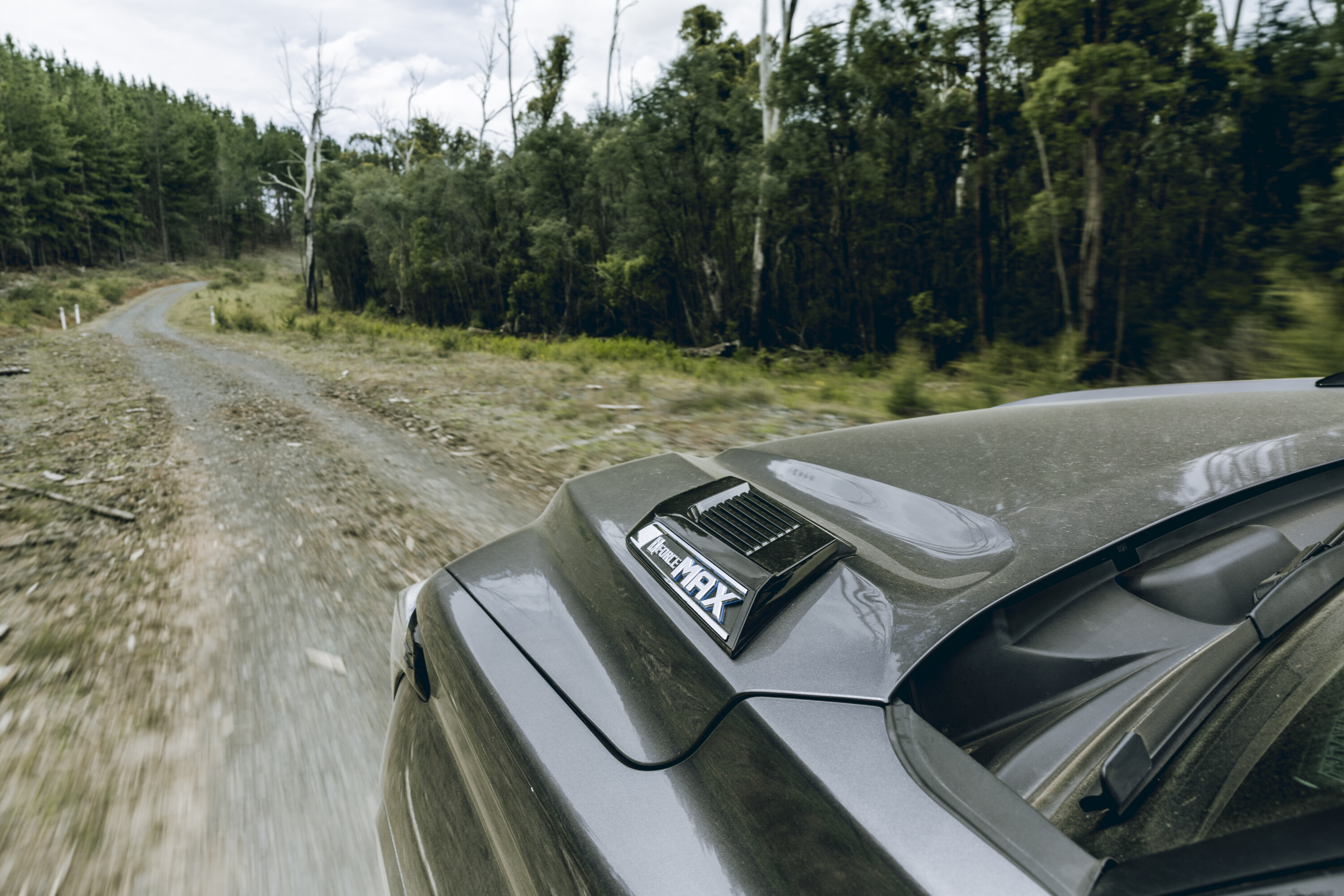
In the case of the HVAC fan, it sits under the dashboard, which itself is an all-new part, on the opposite side of the vehicle to the steering column. With the steering column now on the right-hand side of the vehicle, it comes through the firewall right where the large blower would originally sit, so the LC300 unit was adapted to the other side of the HVAC unit using components developed by Walkinshaw.
Other key components that are replaced in the LHD to RHD process include the front and rear LED lights, the wiring harness, gear shifter and console, and the seat belts among other parts.
Once the vehicle is fully back together it is put through a series of tests that include water ingress, visual inspections and a road test, before it heads out to a Toyota dealer. The conversion is seamless and owners will not be able to see or feel any differences to any other RHD Toyota, allowing the company to offer its full factory warranty.
The 2025 Toyota Tundra is covered by Toyota Australia’s full five-year/unlimited-kilometre warranty with roadside assist. This includes five years of capped price servicing at $450 per service with intervals of six months or 10,000km, whichever comes first.
| Price | $155,990 +ORC |
|---|---|
| Engine | V6 petrol hybrid |
| Capacity | 3445cc |
| Max power | 326kW @ 5200rpm |
| Max torque | 790Nm @ 2400-3600rpm |
| Transmission | 10-speed automatic |
| 4×4 system | Part-time/dual range |
| Construction | Double-cab ute on a ladder chassis |
| Front suspension | Double wishbone with stabiliser bar |
| Rear ruspension | Four-link rigid axle with stabiliser bar |
| Tyres | 265/60R20 tyres on alloy wheel; Temporary spare tyre |
| Weight (kerb) | 2778kg |
| GVM | 3536kg |
| GCM | 7825kg |
| Towing capacity (braked) | 4500kg |
| Payload | 758kg |
| Seats | 5 |
| Fuel tank | 122L |
| On-test fuel consumption | 12.3L/100km |
The Mitsubishi Pajero, a stalwart nameplate in the Australian 4×4 landscape, has been a popular choice for off-road enthusiasts and families alike since its introduction in the 1980s.
Launched as a successor to the Mitsubishi Challenger, the Pajero Sport combines that hallowed nameplate’s reputation for rugged durability with a modern design.
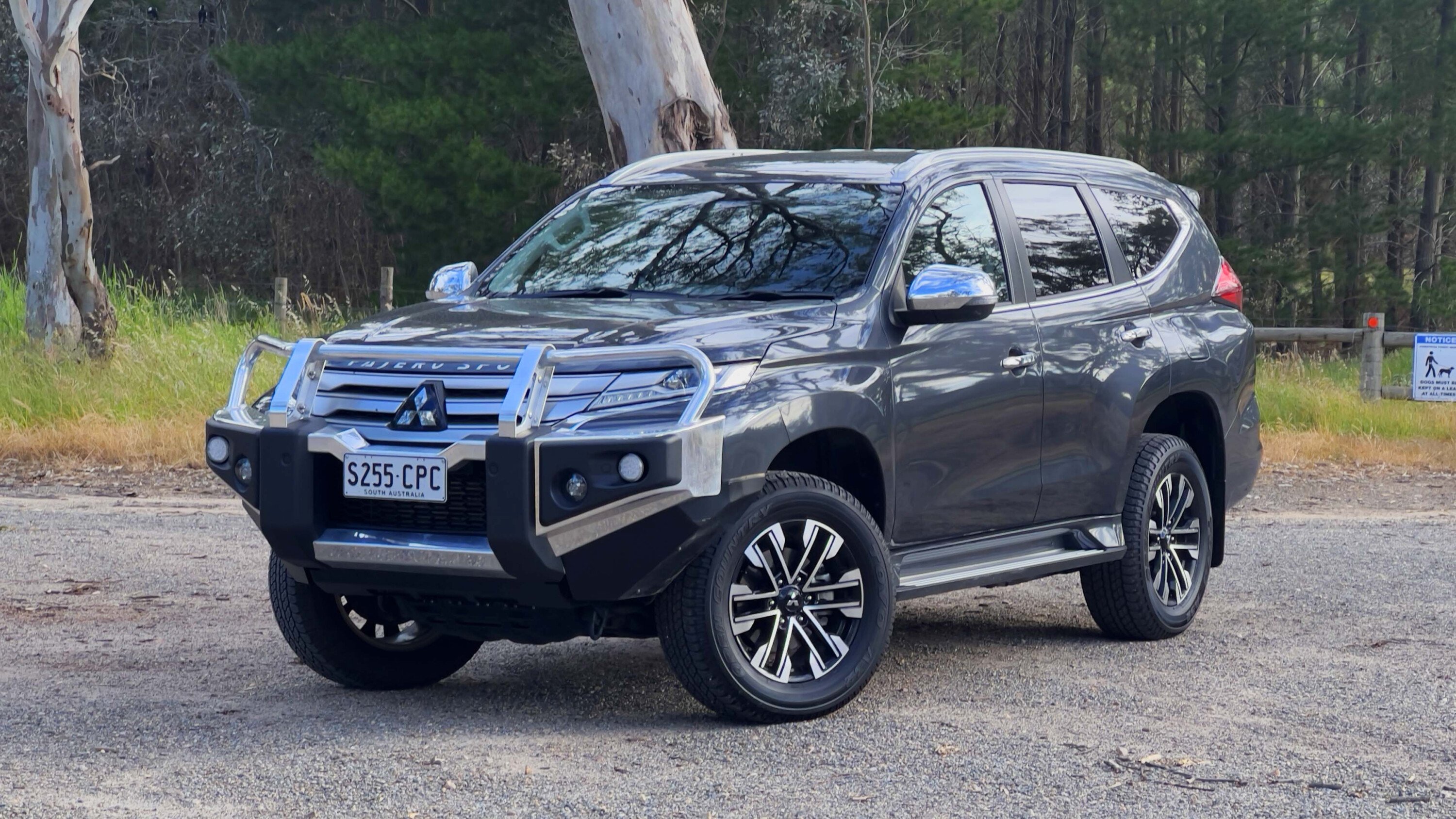
The large SUV, based on the Triton ute is available as a five-seater or seven-seater and as either a rear-wheel drive 4×2 or with a selectable four-wheel drive system.
All use the same 133kW/430Nm 2.4-litre turbo-diesel four-cylinder engine and eight-speed automatic transmission.
Over the years, the Pajero Sport’s reputation for reliability and value for money has solidified its position among top-selling large SUVs in the country.
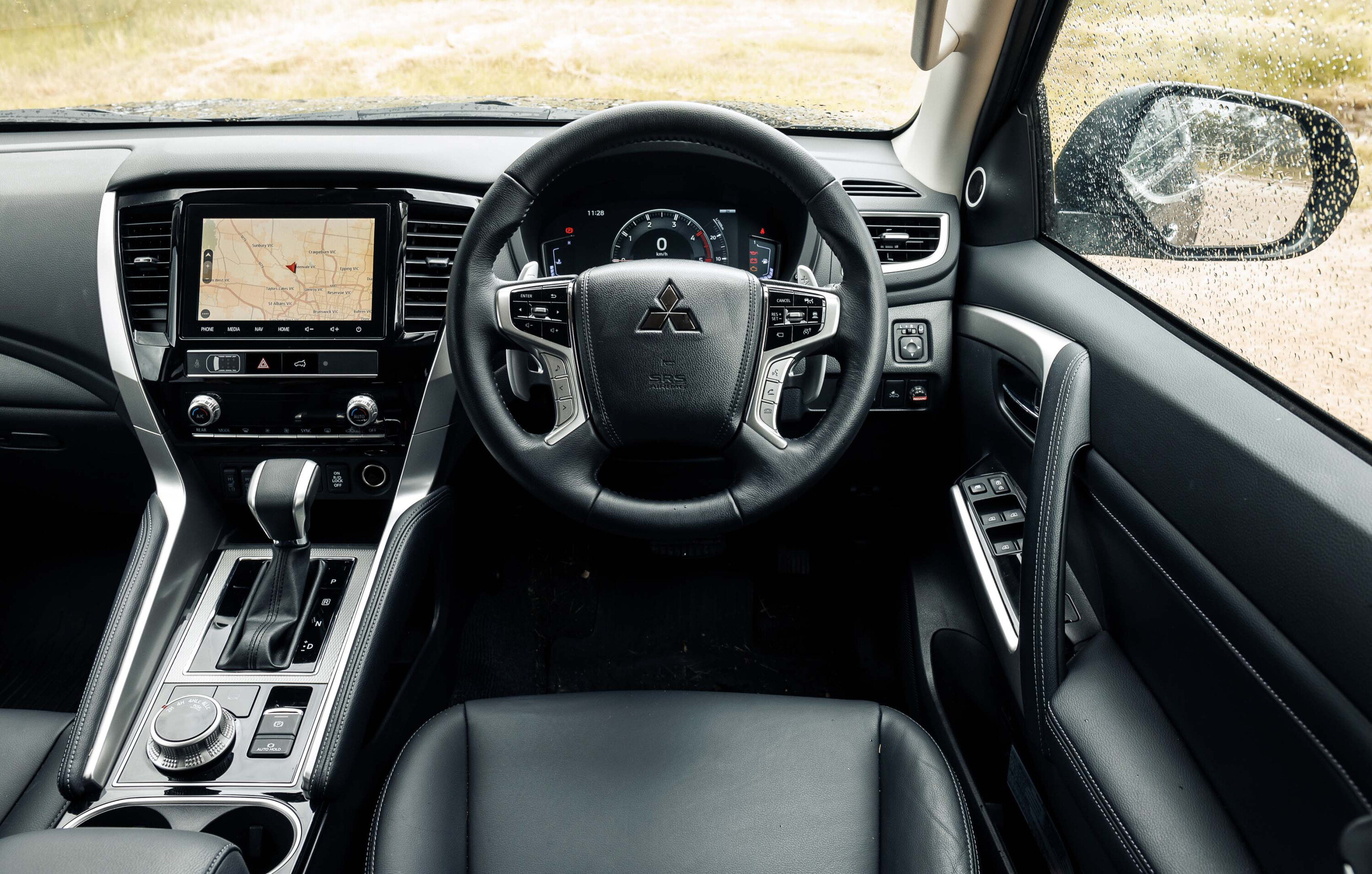
| 2023 Mitsubishi Pajero Sport standard features | |
| 18-inch wheels | Electric adjustable and folding side mirrors |
| 2 x USB Input front; 1 x USB power supply rear | Electric park brake |
| 3 x 12v accessory sockets | Keyless entry with engine start button |
| 4 speakers | LED headlights |
| 8.0-inch central touchscreen infotainment | Rear parking sensors |
| Adaptive cruise control | Reversing camera |
| Android Auto & Apple CarPlay | Roof rails |
| Brake auto-hold function | Second-row centre armrest with cup-holders |
| Cloth upholstery | Second-row seat recline adjustment |
| Daytime running lights | Second-row split folding function |
| Digital (DAB+) radio | Side steps |
| Driveru2019s seat lumbar adjustment | Speed-sensitive intermittent windscreen wipers |
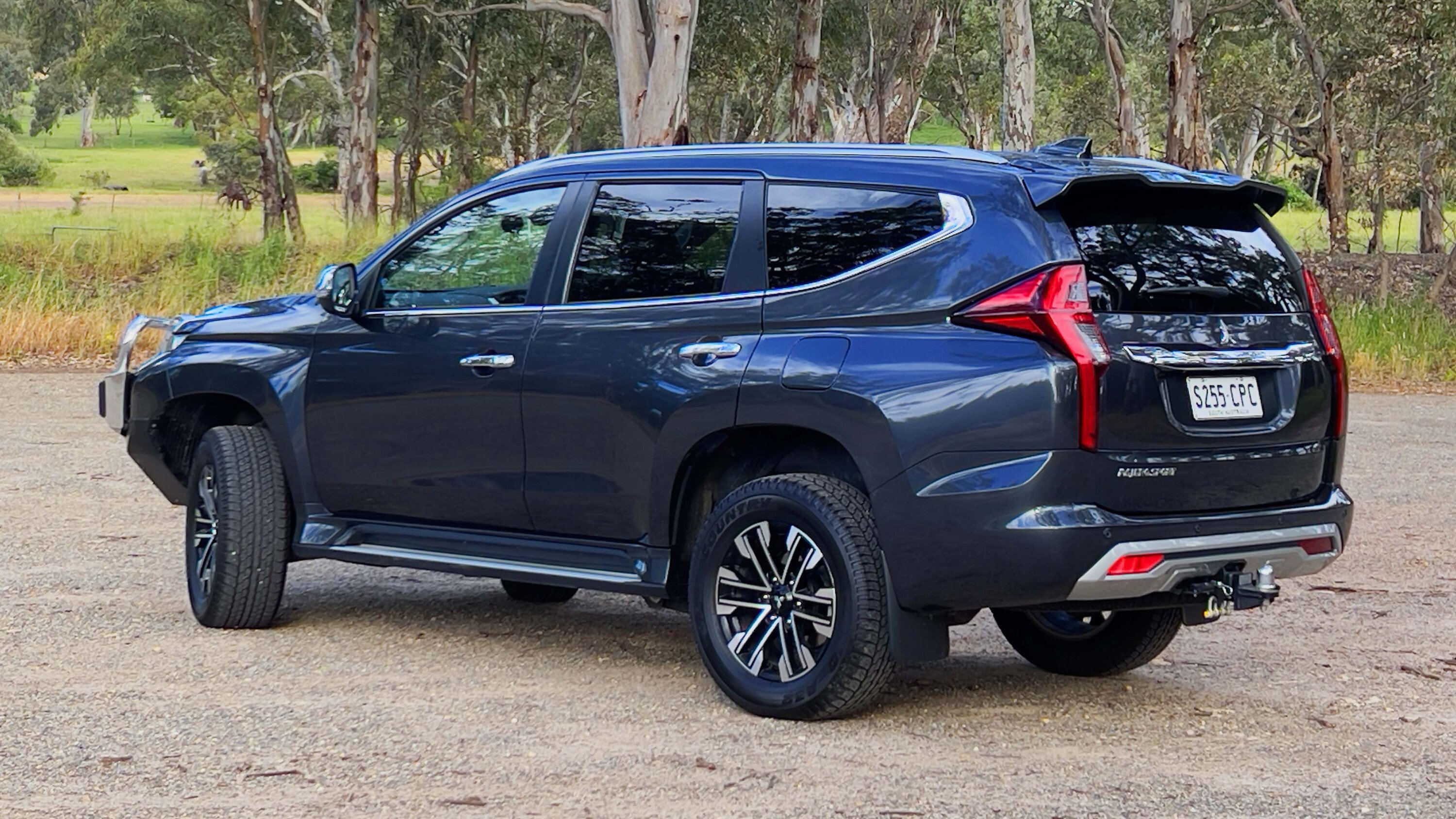
Moving up from base GLX to GLS trim adds privacy glass, a power tailgate, automatic rain-sensing wipers and more.
GLS deluxe adds extra luxuries such as leather-appointed seats and electrically adjustable front seats.
The next variant, Exceed, has those features plus front parking sensors, a larger 8.0-inch infotainment screen and front parking sensors.
At the top of the range, the GSR 4WD adds an array of black trims and garnishes both inside and outside the car– including a two-tone black roof, black alloy wheels and black rear spoiler.
The Mitsubishi Pajero Sport has a maximum braked towing capacity of 3100kg. This indicates that when the trailer being towed is equipped with its own braking system, the Pajero Sport can tow up to this weight.
For trailers without their own brakes, the Pajero Sport has an unbraked towing capacity of 750kg.
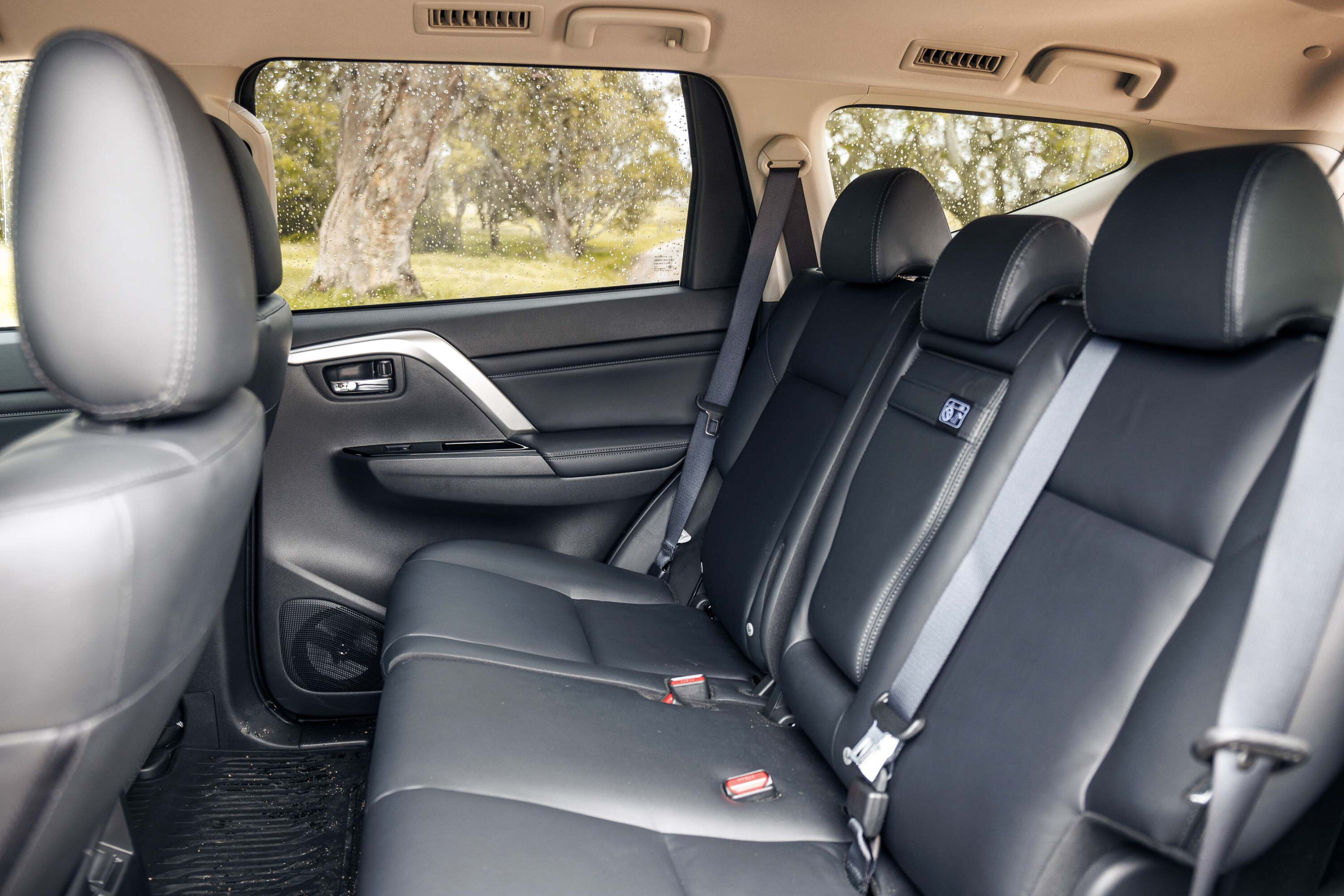
The Pajero Sport towing remains competitive against key SUVs but doesn’t necessarily take first position. At 3100kg it sits just slightly under the segment’s two towing leaders– the MU-X and Everest V6.
Here’s how it stacks up against some of its main competitors:
| Towing capacity (braked) | Towing capacity (unbraked) | |
| Mitsubishi Pajero Sport | 3100kg | 750kg |
| Isuzu MU-X | 3500kg | 750kg |
| Toyota Fortuner | 3100kg | 750kg |
| Ford Everest | 3000 (2.0L FWD) /3100 (2.0L 4WD) /3500kg (3.0L V6) | 750kg |
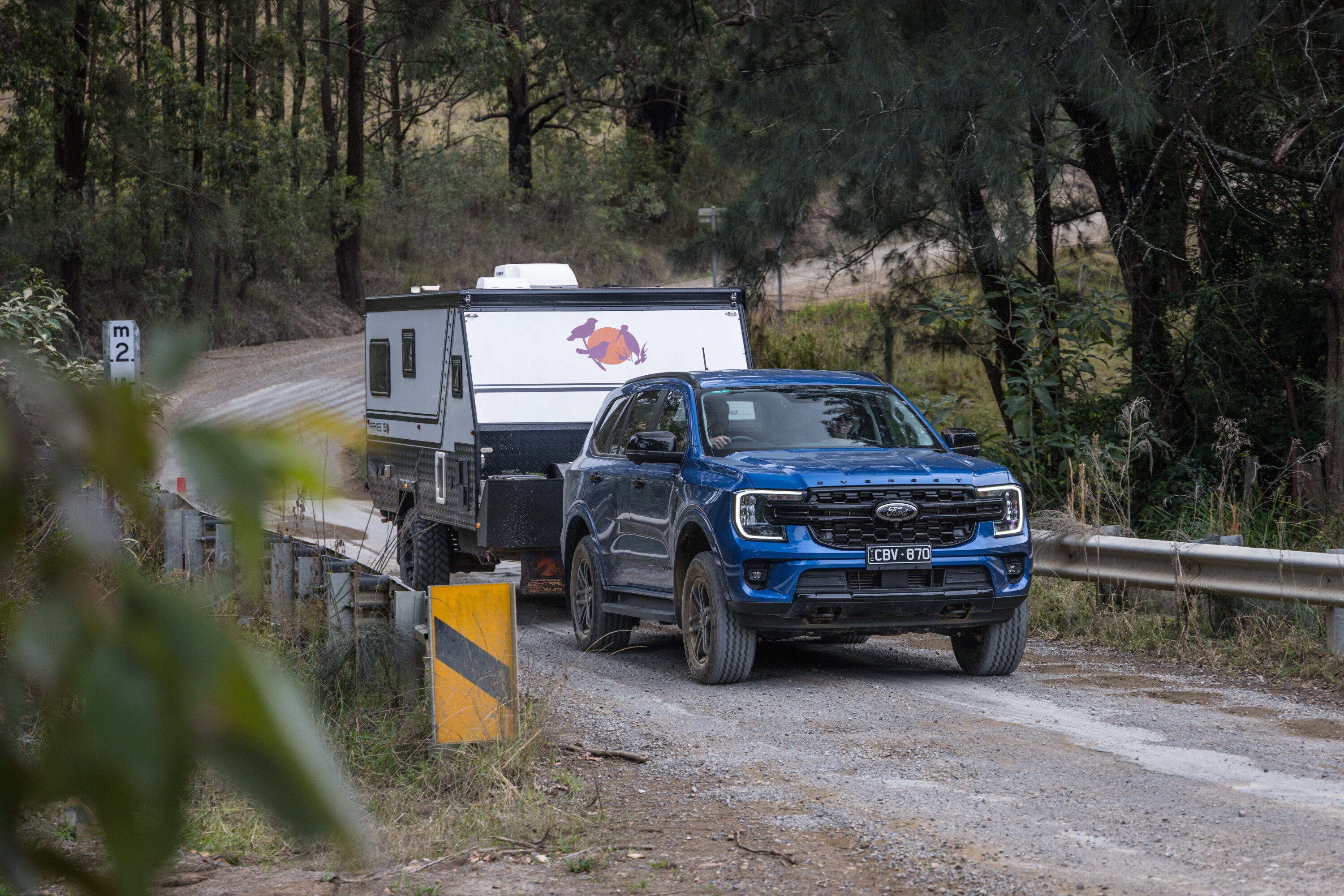
However, a five-star ANCAP score still applies to vehicles built before 1 January 2023.
Standard safety tech includes automatic emergency braking, hill descent control, seven SRS airbags and trailer stability assist to help with towing.
Driver assistance features such as blind-spot monitoring, rear cross-traffic alert and lane change assist are limited to higher models in the range.